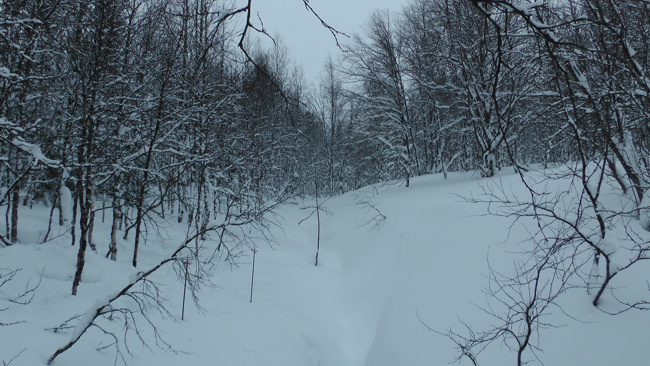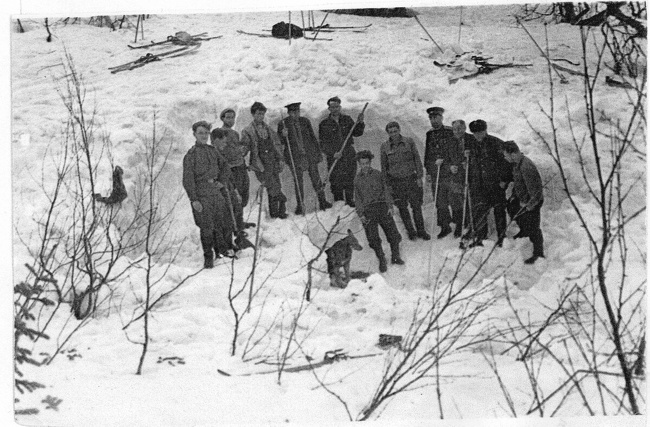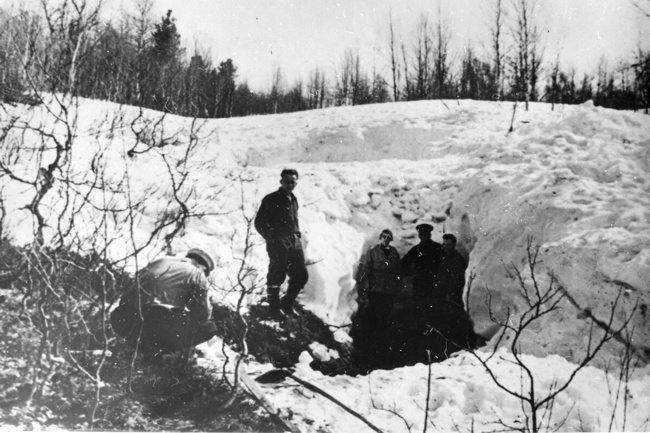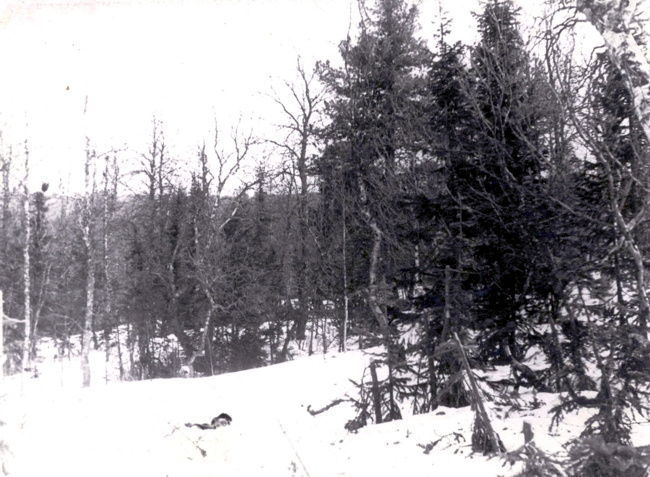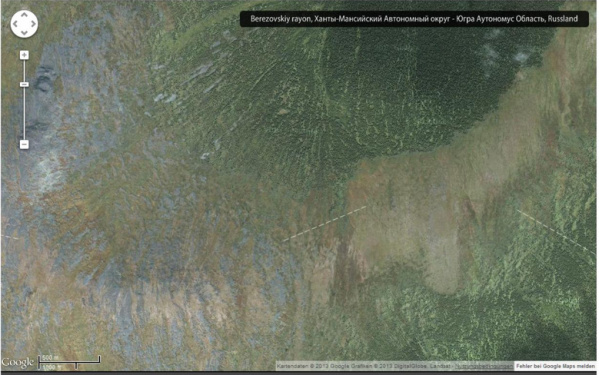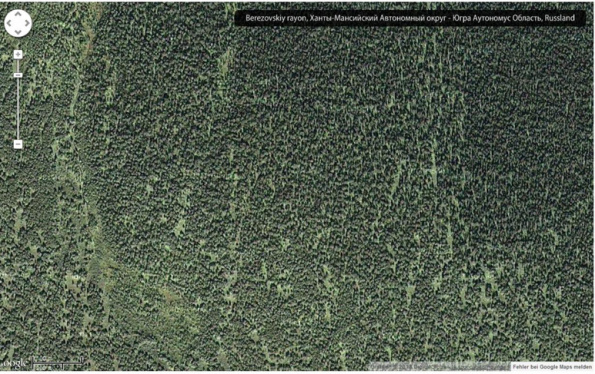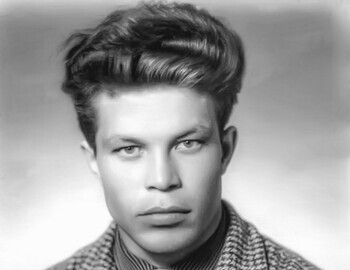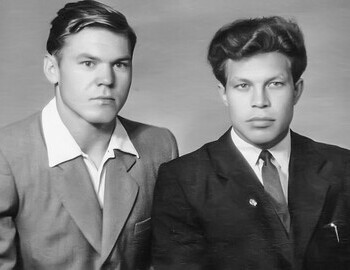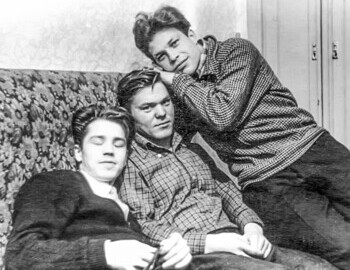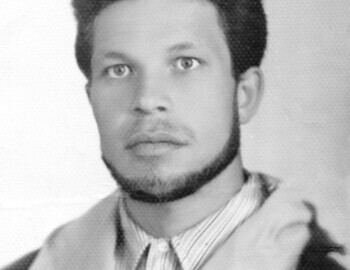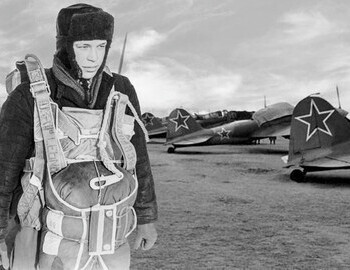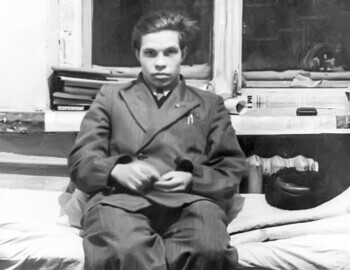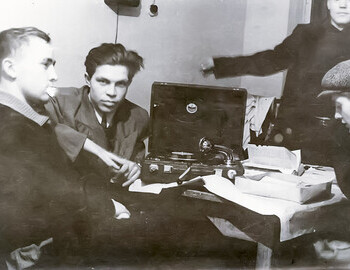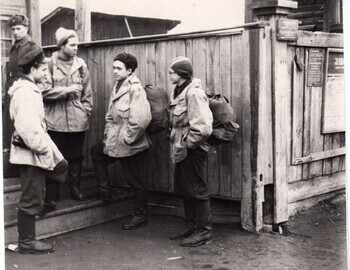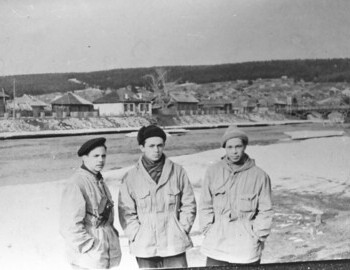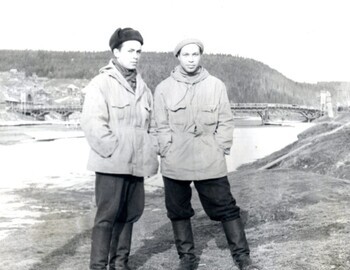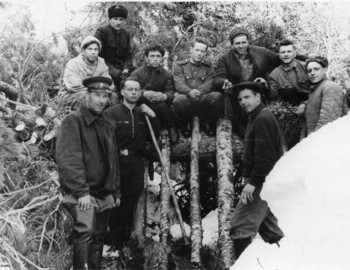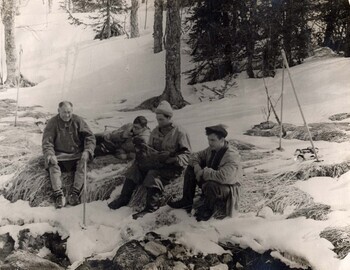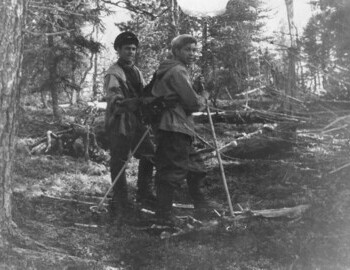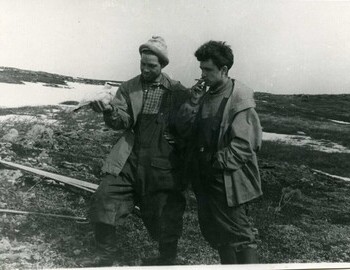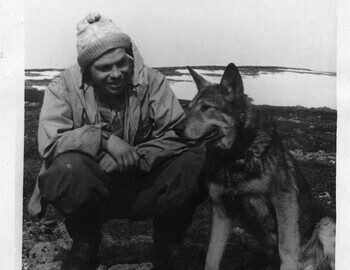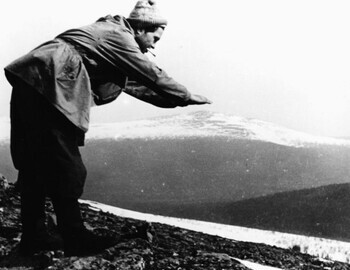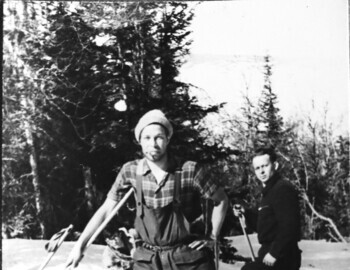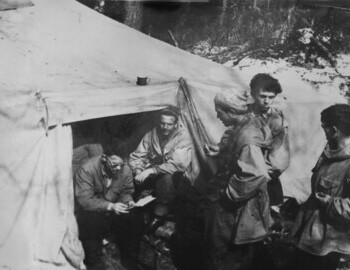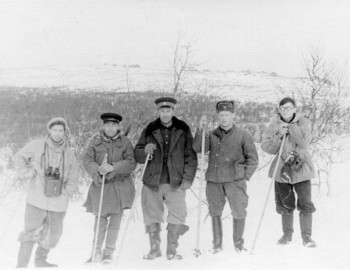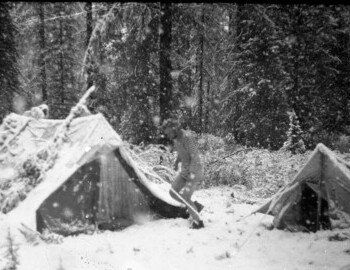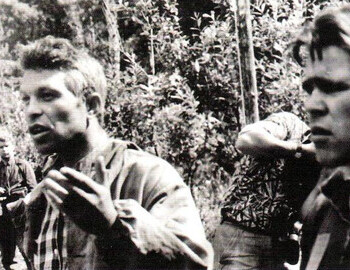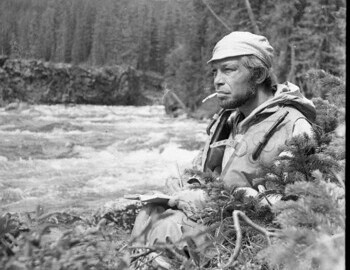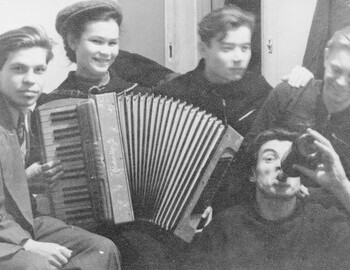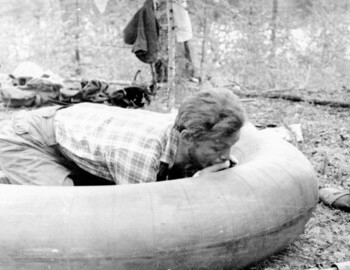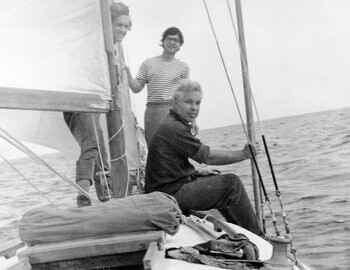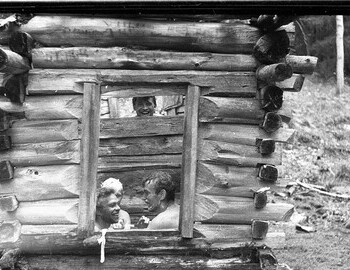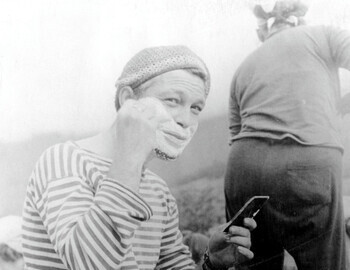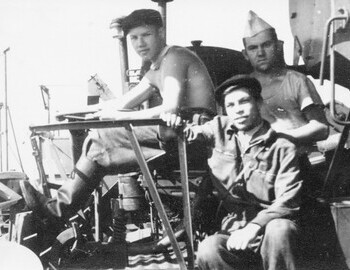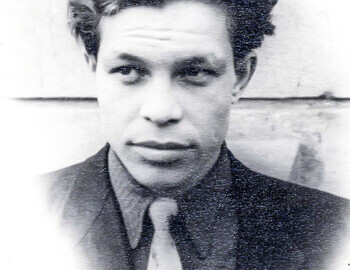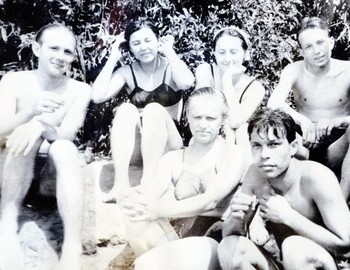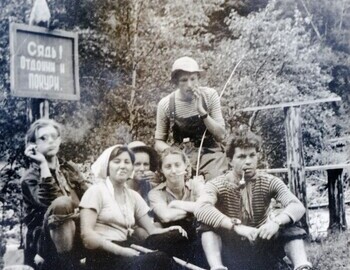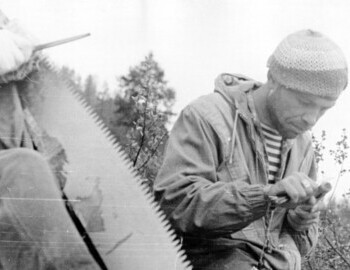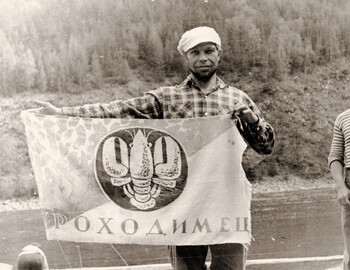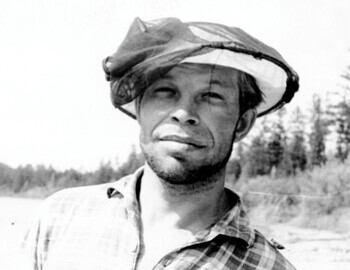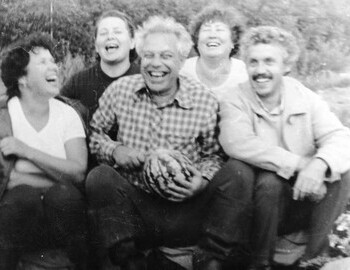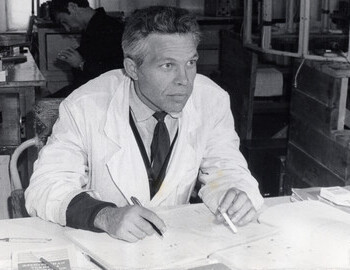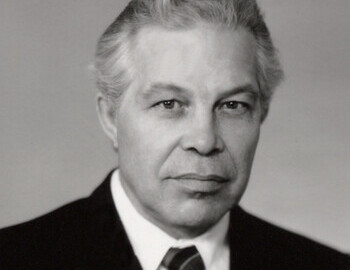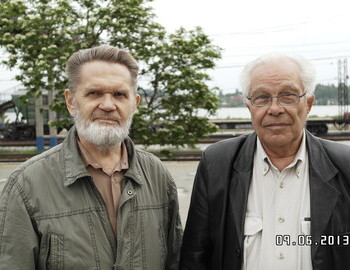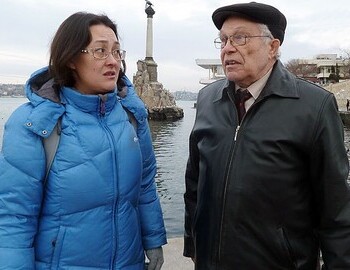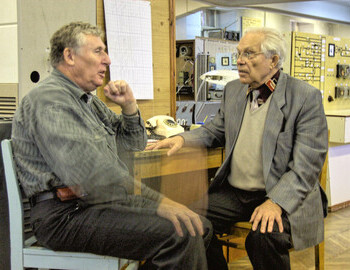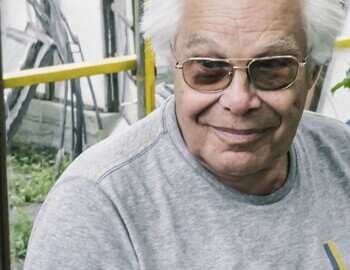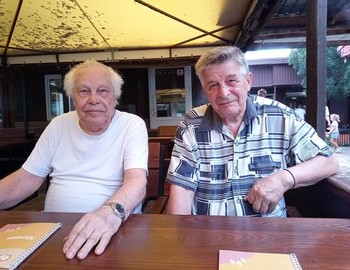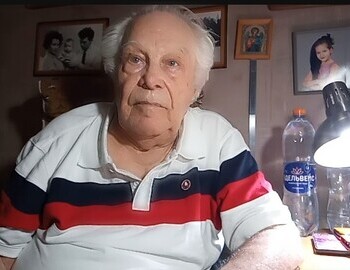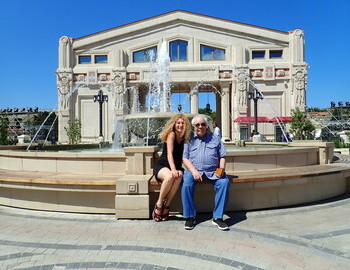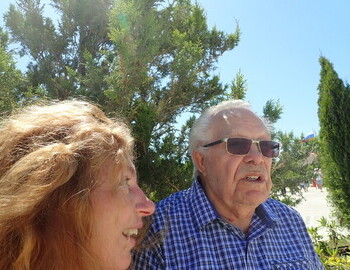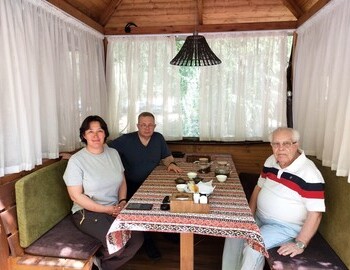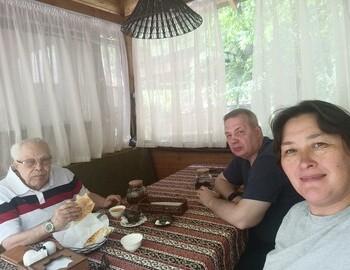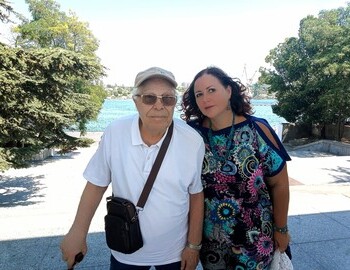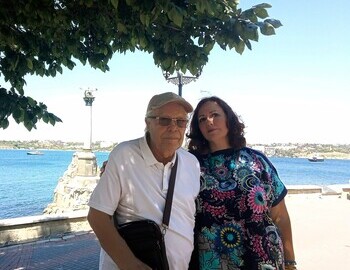
V.M. Askinadzi. Selected passages from 10 years of correspondence with Galina Sazonova
Head of the UPI search party Apr 25 - May 8
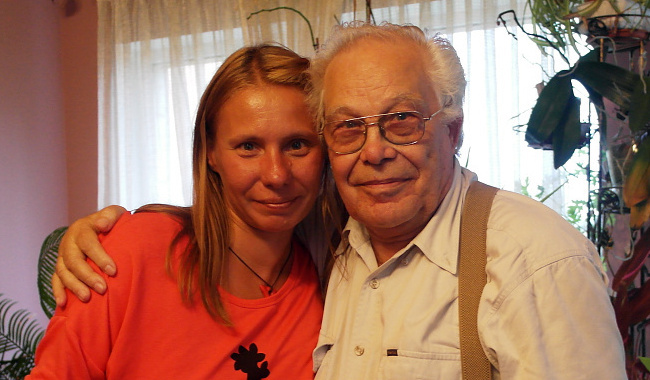
Galina Sazonova and Vladimir Askinadzi
SMART GIRL!!!!
You are an incredible person, comrade Sazonova Galina (what's your middle name??). You have plunged me into a state of prolonged insomnia. What can we say? If the "harmless" introduction brings you a shock, then the main part, one must think, will drive you crazy!! I read and re-read, and will re-read many more times.
Hello, George Sand of the 21st century!
First, a warning: if in your epic novel half of the volume is not occupied by searing sex, and the other half by sophisticated murder and a sea of blood, no one will read it except me!!! Please note!
Galya!!!! Do you save our letters?? If yes, then today I received the 1000th (!!!!) letter from you. Congratulations on the anniversary! And this is in a month and a half. I received the first letter from you on April 30, 13.
Hello, Galina!
Yeah, how wide is the audience for Dyatlov research! Are there still inhabited lands beyond Vietnam!? Philippines? There have been no letters from there yet.
Shortcuts
First letter
April 30, 2013
Hello, dear Vladimir Mihaylovich!
First of all, let me congratulate you on the upcoming Victory Day and wish you health, more joy in life, peace and patience. Especially to such "persistent" pesters like me))
Let me introduce myself - my name is Galina, I am a doctor, I have been working on Vietnam for the last almost 10 years. For several years I have been interested in the topic of the death of Igor Dyatlov’s group...
Vladimir Mihaylovich, I really want you to try to understand why I am doing this. What makes me dig into some facts and bother people (at the moment - you). For myself, I clearly understood this - memory. They deserve to be remembered. So that every day someone new would look at their smiling photos and, at least for a minute, imagine them alive. Yes, maybe the topic of investigating their death is not the best option to maintain memory, but it is not the worst, especially if you try not to mix it with commercial issues.
Personally, I don’t have any theories and on principle I try not to read them, so as not to lose my sense of objectivity, and not to start looking at them through someone else’s eyes. There are small individual facts. And it’s interesting for me to consider them. In the hope that maybe someday they will form one clear picture. In the end, people close to them also deserve the right to know what happened to their loved ones.
In any case, this is a tragedy, and you, wittingly or unwittingly, became a witness to it. As with any tragedy, there cannot be an unequivocal attitude and I will understand and respect your decision, for example, not to respond to my letter.
But if you would still be so kind...))
Looking through the photographs of the searches, I noticed this photo of the den excavation. The fact is that my husband and I have a hobby; for more than 20 years now, every summer we go to work as excavators on archaeological expeditions. At first it was the famous expedition of the Pushkin Museum to Kerch (Pantikapaeus) under the leadership of the gold curator Shliman Tolstikov Vladimir Petrovich, the last 10 years - an expedition of the Russian State Historical Museum.
And so, looking at this photo, I clearly understand that the walls of the excavation were made and cleaned according to all the rules of competent excavation. They are strictly vertical, 2 walls are laid out at an angle of 90 degrees, the walls are "cleaned", they are made very smooth. The walls of the excavation clearly coincide with the boundaries of the flooring itself.
Having dug up tons of earth, I also understand that it is almost impossible to "accidentally" get such a neat hole. If only because leveling walls is a colossal physical labor. Not all men at professional excavations will be able to do this quickly and efficiently, especially when the height of the walls is more than 2 meters. Especially if there is also hard ground (in this case snow).
The fact is that the walls of any excavation contain a huge amount of information, much more than the contents of the excavation itself. It is from such walls that one can accurately track all layers of snow, draw conclusions about snowfall periods and thaws (these are like rings on trees) and - most importantly - only from such walls one can determine whether or not the snow has moved, its sliding, or "falling over".
I want to show you another photo from an archeological site. Behind the young man's back you can see a drawing on the wall. It was from this drawing that it was found out that this was a fortification structure (ditch) and the filling of this ditch occurred as a result of the collapse of one of the walls during a fire (this is an ancient Greek fortified settlement of the 6-7th century BC. Taman) http://s1.ipicture.ru/uploads/20130428/JHsC6ltR.jpg
And it turns out that at the site where the den was dug up, someone carried out similar work. Most likely, these were people who were well versed in the structure of rocks. It seems to me that it had to be one of the geologists. Perhaps climbers.
There are no descriptions of the results of this work anywhere. We could have very valuable information. For example, the idea that the guys were covered by another movement of snow already in the ravine could be completely refuted or confirmed.
And I would like to clarify - do you remember who exactly supervised the excavation of the den, maybe someone gave clear recommendations about who exactly asked to clean the walls and smooth them up?
I really hope for your answer.
Once again with great respect, Galina.
Vladimir Askinadzi :
You think very well about the methodology for conducting search work in 1959. We did not have not only professionals who understood excavations, but also an investigator who would constantly monitor and record new facts. In one of the interviews I already explained how we worked. In the evening after dinner, Colonel Ortyukov gathered a small meeting to sum up the results of the day and adopt a work plan for the next day. As a rule, these operations were attended by the Kurikov brothers (guides - Mansi), myself, as the leader of the student group, and Nikolay, the leader of the group of soldiers. Sometimes Ortyukov conducted operations only with the Kurikovs, without Nikolay and me.
In other words, everything was completely impromptu. There was no strategy or version. There were only tasks for the current day! We'll find it - okay, if we don't find it - we'll look tomorrow! That's why we didn't do any science. They plowed like moose all day so that they could sleep dreamlessly at night.
You probably know how we got to the den. The excavation itself initially went in a cone towards the den. The excavation site was selected by cutting out snow blocks the size of a construction cinder block with shovels. When they got to the den, they began to gradually expand the excavation. You see its final form.
As for studying the sections of the excavation, this never occurred to anyone - without this there were up to our necks in other worries, and, to be honest, we did not know how to do this - to determine some events from the structure of the snow. Often we, the participants in the search, are reproached for not looking at this and not measuring that. It would have been necessary to determine even then that Dubinina had no tongue, and Zolotaryov had several broken ribs. We didn't have such a task. Our task was to find the corpses and hand them over to professionals for examination. Of course, over time, when the investigation materials became available, you reproach yourself in your heart for not doing more, you should have thought about this too. Alas, we can never revisit the events.
Hiking
In the event of the death of a group or individual participants, no one bears criminal liability. If the leader is still alive, then, depending on the degree of guilt, they can punish him according to sports, up to and including complete disqualification. There was such a case in my sports practice. I, as the chairman of the city route commission, approved the group’s trip to the Sayan Mountains. The group, of course, was not a five-stars group. But if I hadn’t approved the trip for them, they would have gone anyway, and when I approved it, I also gave them a detailed instructions, because I had been on this river two years earlier. I explained to them the main landmarks for dangerous places, the approximate time to travel from one rapid to the next, gave them the river navigation chart I had compiled, etc. But unfortunately on the last rapid, after which the river turns into a calm channel, a misfortune happened that ended up with three casualties.
Naturally, they call me "on the carpet" and begin to educate me. But there was also a lawyer at this meeting. It was he who explained to the illiterate that the participants went on the hike without coercion, that it was not a business trip, etc. Therefore, criminal liability could not be applied even to the leader (he also died). They decided to delay my assignment of Master for two years. I didn’t mind, especially since the deceased leader was my friend, and I felt sick without punishment!! My wife worked with his wife. I was a member of the Central Committee for Water Routes of the Ural Regions, and I was aware of emergency cases in the Union. In my experience, only one Master of Sports was disqualified to zero.
–
At all times, confirmation of tourist qualifications was only certificates of completed trips. The leaders had to watch for this. Certificates were issued by the Route Qualification Commission (Route commission form here on - ed.) after the group’s report on the completed trip. More often, the certificate forms were filled out by the leader, and the Route commission only stamped them. Unfortunately, I didn't keep any forms, although, as an almost permanent leader of treks, I had several dozen of these forms at home. The certificates indicated only the full name and characteristics of the route (start and end dates of the route, region, route line, group affiliation with one or another sports committee, for example, "Burevestnik").
This was enough to participate in a trek with any leader. No one ever demanded additional documents, especially characteristics of a participant in the expedition. If the participant formally corresponded to one or another route, only the leader decided whether to accept him or not!
–
In our understanding, this group consisted of random participants. And this happened often, especially in student groups. After all, the participants studied at different faculties, they had different session dates and other restrictions. It was almost impossible to maintain a single group capable of going on a hike of the highest category. To do this, you need to hike together for almost 4 years. Although, students, like any young people, quickly became friends, because they were in similar ages. After all, Zolotaryov was a foreign body in terms of age, qualifications, and behavioral stereotype. A front-line soldier who survived the war, and not a kid from school. They got away with it for the time being, until the bell rang! But even after this, in the guidelines on the qualitative composition of participants, only one requirement was presented - compliance with qualifications. Whether he went with this group or not, whether the leader or participant had a problem with psychological compatibility, this was not considered. Everything was left to the leader. But even in the event of a tragedy, the leader was not subject to jurisdiction, since the participants went on the hike voluntarily. He could have been disqualified, but no more! Upon completion of their studies, many, having been leaders during their student years, were unable to continue this occupation - they simply could not recruit groups with the appropriate qualifications from the employees of their enterprise. It was too much of a work to gather and train a group by ourselves so we didn't do it for one reason or another. I "prepared" my group from scratch. I started teaching them how to pitch a tent, how to make a fire in the rain, etc. After 10 years, the participants included 4 Masters and 2 candidates for Master. But this, I think, was a unique phenomenon. But Lev Afanasyev, already almost known to you, never managed to go with a permanent group composition. Half of the participants changed almost every year. Afanasyev’s cool leadership style was to blame for this (May the Kingdom of Heaven be upon him!). What happened was in part because they were randomly put together!
If, according to your chronology, sports tourism died in 1961, then I can inform you that where I was in 1961 and subsequent years, 7 to 10 groups gathered at the same time at the initial exit points. People walked actively, despite the lack of proof of qualifications. We didn’t go for the sake of shock, although it was a shame. I knew nothing about these decisions. I was guided only by conversations with direct participants in the work with functionaries of the All-Union Central Council of Trade Unions.
After all, in Russia from all the way back, laws were not created in order to be followed. These decisions were not even communicated to sports clubs. I, as the chairman of the city club, was not even introduced to them. I think that the city Sports Council was not aware. Maybe only the Regional trade union council was aware. By the way, I don’t see any contradiction between our versions. While the All-Russian Central Council of Trade Unions was relieving itself of yet another headache, working groups were preparing documents for approval.
Evgeniy Buyanov has information, if I remember correctly (you can check with him), that about 200 groups died before 1965, so the death of the Leningrad group is a local surge of discontent among the elite. On my account there are 64 corpses both group and individuals!!! These are my friends and friends of friends.
For example, I’ll tell you how in 1967 they searched for a dead group in the Sayan Mountains. The search was paid for by the enterprise. As soon as the director was convinced that the group had not gone to China (!!!), the search immediately stopped and no one was given a report! There was just an exclamation: "Well, thank God. They didn’t go abroad!"
That’s what they were afraid of?!
And our city Routing commission continued to work, but not only as a controller, but, above all, as a consultant and assistant in organizing accident-free treks.
Ranks and titles were the last thing remembered!
Still, the momentum for the elimination of hiking as such was the event at Otorten. Or rather, not to liquidation. The All-Union Central Council of Trade Unions decided to suspend sports tourism until new, unified, guiding materials on hiking are created. All documents on the Dyatlov group were sent to Moscow where they probably saw the chaos and confusion in sports tourism. There were no uniform operating rules. Each regional tourism council functioned practically according to its own rules. This had a particularly detrimental effect on the Routing commission. The development time frame was not specified, but hikes, especially those of the highest difficulty category, couldn't be approved until the guidelines and qualification documents were reassessed. Whether to go or not is decided by the leaders and trade union organizations on the spot. For six months at the local level, treks were even approved, more by inertia. The epic development, coordination and approval of documentation took more than three years. By the way, Kirill Bardin was also in the development group. In 1962 (before the documents were approved!) we met in the Sayan Mountains (both he and I had an A+!), and around the campfire he told me how fluid the process of developing and, most importantly, approving the documentation was going. You probably noticed that before 1959 there were three categories of difficulty, and after 1964 there were five! Until 1959, there was no qualification division of expeditions when approving the highest ranks and the title of Master, i.e. it was possible to have an succession of trips (both summer and winter in total), then after 1964 qualification requirements for types of tourism were introduced. Even water routes were divided according to the type of watercraft - it was impossible to replace kayak trips with raft trips and vice versa.
–
But the people continued to go, although many, having suspended their trips until the appearance of, especially qualifying documents, never returned to sport's tourism. Examples of this are Valentin Yakimenko, Zhenya Zinovyev, etc. I, being "the most important hiker of the city", at all meetings tried to persuade people not to give up sport's tourism, that anyway, sooner or later, sport's tourism will be legalized. The authorities simply had no choice; the number of victims multiplied, although planned sport's tourism began to develop at a gigantic pace. There was a massive construction of sport's centers. Maybe Zolotaryov also caught this current?
This is how the expeditions were carried out in one year, and approved much later. After 1964 (I attribute this to the eccentric nature of Khrushchev’s regime), there was no more persecution of sport's tourism. Moreover, since 1965, when treks carried out during the "forbidden" period began to be protected, there has been a stream of mass conferment of the highest ranks and the title of Master of Tourism. Repaid debts!!
–
I, as the city’s sport's tourist leader, and also having frequent business trips to Moscow (because of them, I was a week late for my own wedding!), was a regular at the Central Tourists Club on Sadovo-Kudrinskaya. It always functioned, even during the forbidden years. I had a lot of friends there, and not only from Moscow.
–
Galina Sazonova :
Bardin was also a Master of sports, and this was only through the Central Routing Qualification Commission. Of course, he could have been sent on a business trip by some other enterprise in agreement with his family. Do you have any reports from Kirill? What did he find there? I still don’t know in detail the purpose of his visit. As a ski touring expert? But there were Maslennikov and Akselrod. Isn't this enough? Of course, just as we were asked to check the fact whether they had gone to America, they were frightened and sent there the necessary and unnecessary specialists. This was common for the party leadership at that time. Don't be angry with me!
Vladimir Askinadzi :
It’s a strange thing, we spent almost a whole month with him in the Sayan Mountains and never once remembered that we were on the search, though at different times!
What can we say if Boris Martyushev, two months after the death of the group, in his reporting and re-election report Martyushev did not say a word about Dyatlov!!! After 2-3 months, the city calmed and people stopped talking about the incident. Such was the time!
–
I wasn't really friends with Kirill Bardin. We accidentally met on the Sayan Mountains (Kazyr River) with a group of Muscovites, where Bardin was one of the participants. During one of the gatherings around the evening fire (we slept in the same camp), he was surprised to learn that I had participated in the search. This was something we had in common. When we parted, as always happened at that time, we exchanged addresses. While on business trips in Moscow, we met with him several times, but these meetings were not only with him - we met with members of the group. With cognac, Olivier (Russian salad) and herring under a fur coat. This was how we met. Then the meetings naturally stopped.
–
Speaking of a club where no one knows anyone! Same applied for the UPI club. At best, these were group leaders who were known to others. Members of the same group rarely knew each other. This is a completely normal situation. Many of us were put together by the search. I did not know, and would never have known Yudin, if not for the Dyatlov group tragedy. Same thing with Sogrin, Sharavin, Akselrod, Bartolomey and others. Communication was rare, even at reporting and re-election meetings. Gatherings around the fire, especially in winter, were good. Sometimes 100-200 participants gathered. One could meet new people and sometimes groups formed. They directly approach the leaders and say that we know that you are going there in the summer, take us with you! This is how it went back in the days. But in everyday life, as a rule, there were no contacts.
–
But then, like Dyatlov, the second half of January! I don’t remember the exact date, but the session began immediately after the New Year. Back then they didn’t celebrate for 10 days. And sometimes it was possible to shorten the sessions by passing one (less often, two) exams ahead of schedule. This practice was quite common, and the teachers did not object. Passing an easy subject early made it possible to increase the number of days for preparing a difficult subject. This is how it happened with my group - we went out earlier, "walked" for two weeks and returned before the control dates of Dyatlov’s group. Therefore, I knew about the tragedy from the very beginning. And Yuri Yudin generally returned, in my opinion, to the institute in mid-February (we need to check the documents). Back then it was very strict about being late for the start of classes!
My hikes cannot be compared with winter ones. I am a water sportsman. My specialty is navigating mountain rivers on rafts (by kayaking is another specialization). Well, where is a river, there is a fish! We took with us a relatively large amount of vegetable oil, flour and salt - everything for the fish menu. We didn't take meat products, took relatively little cereal (there were plenty of mushrooms), etc. But I honestly wrote in the application documents what the instructions recommended.
In our time, Academician Okladnikov’s two-volume "Traveller’s Handbook", designed for professional travelers (published in the 1920s), has enjoyed success. All the norms and recommendations were outlined there. But there was also a huge section on how to pack a horse!
Then Przhiemsky published the book "The Raft on a Tourist Journey" in 1957 (?), practically rewriting the norms of the "Handbook".
And Maslennikov demonstrated his erudition, nothing more! You know, I don’t remember being thirsty on the ski route. Therefore, there were no problems with water. On the contrary, there were more problems with the toilet if the ski track goes along an open area, for example, along a river. The girls asked us to go forward and not look back. We endured as much as we could, but then we asked them for the same. And now about alcohol. Only bigots talk about the fact that they didn’t take alcohol. They took it for medical purposes and for others. For "other" purposes they took 10 times more.
During the route (it took 4-5 weeks) we drank at least 12 liters (!!) of alcohol.
For us, drinking alcohol was a ritual. For this role there was a constant, year after year, "breeding". He said that alcohol is a medicine and should be taken 15 minutes before meals! In the evening he took out special cups (at that time there was a hunting set of 10 cups nested inside each other). Each year, year after year (we zealously observed the traditions we had once developed), we had our own glass. Mine, for example, was always second. My wife had the last one, the size of a thimble (we were married by tourism). Exactly fifteen minutes before the meal, the procedure for taking the medicine began. We poured a full glass and drank together, accompanied by some toast that was relevant for the day. There were no snacks other than water. After 15 minutes, the cooks, who were also being treated, invited us to the table. That's how we did it!
It was a very good remedy for sound sleep. There were days when when we passed 10–12 rapids. You'll break down so much in a day that you won't feel your back. It was necessary to relieve the fatigue. If you don't overdo it, alcohol helped a lot. In the morning we got up fresh, ready for new adventures. And so every day!
In Trans-Baikal there is a river with the affectionate name Tsypa (Chick). There are 175 rapids along 300 km. In essence, it is a washboard with small pools for relaxation and to catch your breath. Can you overcome this without alcohol?
–
We the people of the fifties-sixties, of course, were not saints. But the dispute that is going on between you, it seems to me, is pointless. Each specific situation requires time to analyze and make a decision. It can be quite long, and the person calmly chooses an algorithm of behavior. But if it is no time for this, then spontaneous decisions, often dictated simply by instinct, are very likely. For such cases, a person must be prepared in advance to get out of a possible emergency situation. It seems to me that not a single normal mother, if she is not taught in advance, will first save herself and then her child. That is why Aeroflot, knowing that there is practically no time to make a decision, "drills" into the passengers’ heads in advance an algorithm of behavior that is contrary to instinct! If the sacrifice is constant (rescuers, firefighters, orderlies at the front, etc.), then, of course, he will "fasten all the buttons on his padded jacket in advance". I also had emergency situations during my hikes. The passage of difficult mountain rivers often created them. They (situations) teach you to make decisions quickly. A unique list of methods for getting out of typical situations is being developed (someone was thrown off a raft at the threshold, etc.). There were also those when it was necessary to save the rescuer! But there was always time to first instantly assess the situation, and then make a decision. This is the experience of a leader (by the way, among the leaders of difficult hikes, phlegmatic people did not linger, no one wants to go with them!).
–
The main problem you raised is who was responsible for what at that time. I will tell you as an eyewitness and participant in these events. And not only at that time, but also much later.
What does it mean to be "responsible for something"? If this is a permanent and not temporary duty (official!), then he must delve into all the nuances already at the preparation stage. If Marshal Rokossovsky was responsible for the outcome of Operation Bagration, then he participated in its preparation from the very beginning. It would be funny if, being unaware of the matter, he began to get acquainted with the situation to see how hard the kick would be from the Supreme!! This does not happen, and has never happened, including in sports!
What really happened (I speak as an athlete who confirmed his 9 trips of the highest category - fives in the Route commission of different levels)? No one wanted to answer for anything, since there was neither the desire nor the opportunity to participate in the preparation of countless treks. A hierarchy of positions existed, but the higher the level, the less the nomenclature wanted to be responsible for anything! At first, everything was brought down to the level of the Regional Route commission (except for the A's), then, as the Route commission members achieved qualifications, the approval of all treks, except for the A's, was handled not only by the Regional Route commission, but also some city Route commissions. Then some Regional Route commissions received the authority to approve fives, but for specific types of sport's tourism. For example, in 1967, the Chelyabinsk Route commission had the right to approve top fives in mountain and water (except for kayakers) types of tourism. Ski and hiking routes were established in Moscow for a long time, until Poluyanov received a Master in hiking, and the Master in skiing, which Lev Afanasyev received, was not enough for the powers of the Regional Route commission - in my opinion, it was necessary, I think, three Masters in specialization within the Route commission.
But this structure could not be effective, everyone understood this. Otherwise, afraid of approving a "failed" route, the Route commission turned into a judicial body interrogating with bias. Approval of one route took 2-3 hours!! I remember that I, being a Master of Sports, approved the next route along the Sayan Mountains, and a member of the Regional Route commission forced me to explain in detail how I was going to build rafts?!! I knew him because I went with him in the same ski group to the Kola Peninsula. At first I wanted to be indignant, they say, ask something more significant, - after all, this is not the first time I’ve been on rafts. But the commission members began to insist, because they want to make sure that nothing bad will happen to us due to an incorrectly assembled raft. With chalk on the blackboard, I gave them a short (!!) lecture on the technology of building rafts! This is how it was!!!
Over time, we found the best option - the leader of the trip is responsible for everything!! Moscow and the Regional Route commission approved the routes on formal grounds, and therefore approached everything formally. The leader must know everything and be responsible for the decisions made, both at the preparation stage and on the route. The only "consolation" is that the leader, even in the event of an accident, was not sued! In the worst case, disqualified, completely or partially, or for a certain period of time. The participants voluntarily agreed to go with him! But the route must be formally approved by the Route commission of the appropriate level, at least in order to know (God forbid) where to look. We paid special attention to the deadlines! Of course, the Dyatlov tragedy stirred up a hornets nest of the highest, Moscow, level! Out of fear, they began to look for random culprits, found them and punished them. To be honest, of the entire list of those punished, Gordo was the least guilty, the most affected and, probably, the most decent.
–
I once wrote to Maya that hiking BEFORE Dyatlov was one thing, and AFTER Dyatlov was completely different. As for the leadership of the winter second degree, he could either agree with the local Route commission, for example, with any one, but not Sverdlovsk, or arrange it retroactively. The most likely option was that he simply received a certificate of leadership of a second degree from the management of the tour base, having completed some complicated planned route. They could have issued a certificate at the Kaurovskaya tour base, but there was no a second, but a trivial first degree.
The test for completing the route was a certificate that the leader received after reporting to the Route commission about the hike. Individual certificates were issued for each participant to the leader, who then distributed them to the participants.
–
Galina Sazonova :
I now have the feeling that Zolotaryov was brought to Sogrin by Kikoin! Sogrin is a climber and, it seems to me, idolized Kikoin. Kikoin is not on any of the hiking committees, but he still occupies the status of someone who will not be refused and whose recommendations are respected. But where did Kikoin know Zolotaryov from? Do you know what really confuses me about Kikoin? I can't figure out when he became a climber. Even before the Second World War, he was already in charge of training mountain riflemen at a special school of the NKVD. In general, he was closely tied to the NKVD during the Second World War and until 1946 he would be part of Sudoplatov’s department S. In general, it’s understandable why he never talked about it.
Vladimir Askinadzi :
In groups going on routes of higher complexity, the participation of a certain number of participants who did not formally meet the requirements of the guidelines was allowed. Therefore, Zolotaryov could pass approval without information from Kikoin.
–
(about the tragedy on Kodar ridge, 1961)
Galina Sazonova :
Tell me, is it normal that the experienced and responsible hiker Korolyov first gathered a group of less experienced ones, persuaded them to go, and at the last moment abandoned them, afraid of the instructions??? Or am I missing something?
Vladimir Askinadzi :
It is his right whether to go or not. If he had abandoned them when they were already on the route, then he would have been a scoundrel. But here he decided not to risk his life’s career and announced his decision long before his release. These are adults who themselves could appreciate both the complexity and danger of the route. And his tourist qualifications!!! I don’t know Korolyov’s qualifications, but Volodya Belyakov was far from a beginner in hiking. True, they chose not a walking route, but a mountain-trekking route, and this requires different knowledge and different qualifications. He was absolutely not ready for water, especially the passage of Sygykta.
I once prepared a trip to Sygyktu, but did not dare to go, having assessed the capabilities of both myself and the group. I knew that when pronouncing the name of this river, an obscene word was added through a dash, which characterized its nasty character!
But it was interesting to read the diary. The very fact that they spent a lot of time on reconnaissance (several days in total!) indicates that the campaign was poorly prepared. Sometimes more than six months could be spent to prepare well for an expedition; the necessary information is obtained bit by bit. Even before setting out on a route, the leader must know it like his own apartment - he must be able to navigate the place freely. Another thing is that it takes years to achieve! That's why in my mountaneering life there are 64 corpses and not one who went with me!
And one more thing. Being left with four people, without tents, and deciding to continue the hike is an absolute reluctance to calmly assess your capabilities. It was suicide. No tourist qualifications are needed here, you just need a common sense. There were plenty of such "suicides" at that time, but with their lives they accelerated the birth of mountaneering at a different qualitative level. A high price, since the lives were young!
I knew about the death of this group for a long time. Moreover, when tourism had not yet been banned, Volodya Belyakov and I managed to go to Altai in the summer of 1959. This was my last hiking trip. It was so poorly prepared that at the end of it we didn’t want to meet each other. This was how we reacted to unjustified difficulties that could easily have been avoided.
There is kind of a weak excuse - the cartographic material was so bad that we walked more guided by the sun, and sometimes we couldn't see it for weeks. To the question of where we are now, the most accurate answer was: "somewhere in Altai".
And Pyotr’s material* allowed me to experience another epic in my life. (Reference to Bartolomey’s report on the results of the search work on Kodar (Sygykta River), where Volodya Belyakov’s group died in 1961)
There were seven people in the group, but three, including a girl with a broken leg and the leader, who was also injured on the descent from the Bear Pass (Kodar Range; Trans-Baikal), returned, and the rest continued the route. The leader waited until the last conceivable moment and did not sound the alarm for fear that if they found out about the trek, they would all be expelled from the institute.
The bodies of two boys were found, greatly altered, literally falling apart, the sight of which caused horror even among men who had seen a lot. Pulling and transporting the bodies of the dead from the foaming canyon was fraught with great risk and danger, but we managed to do it. We buried two in Bodaibo, but unfortunately, the other two bodies were never found.
A further ten-day search led to nothing. After a month of work, the rescuers could no longer stay in the taiga, the money for aviation ran out and the supply of food was drying up.
I sometimes have the feeling that all my memories are like a movie I watched long ago and half-forgotten. Some episodes are firmly fixed in my memory, while others emerge unexpectedly, as soon as you read something close to your "film". I remember someone’s actions, but I can’t remember their faces!
–
When I was a student, I didn’t know Sharavin, Bortolomey, and I didn’t know Yakimenko well.
The section was institute-wide. Tour groups were recruited either from the same student group, or dormitory, or were inherited, as I had two girls whose leaders left the institute. If there were other acquaintances, it was either at a rally where the tents stood nearby, or at meetings, etc. Will you remember everyone? And my memory fails me. Sometimes you see a familiar face in a photo, but you no longer have the strength to remember who he is.
–
Galina Sazonova :
Vladimir Mihaylovich, how many route books were issued before the trip?
Vladimir Askinadzi :
None at all!! We took blank route book forms and filled out as many copies as we were not too lazy to fill out. We, the leaders, knew the minimum required for regulatory organizations. As a rule - three. But once, although without stamps, I left a copy of the route book to my parents. The most reliable and interested party, if anything happens... Once the police at the starting point asked for a copy of the route book. In the end, I had about 5 route books with stamps. Of course, the specifics of water trips also affected this. Often the route books were destroyed by the water. Therefore, after receiving the stamp at the initial point, usually at the post office, the control copy was sealed in a plastic bag (we knew how to do this well).
Galina Sazonova :
I understand that the most valuable thing in the route book were the stamps at the starting and ending points? Everything else could be entered by hand at least 100 times. But it turns out that you stamped all 5 routes at the same starting point? And how did the postal workers feel about this? It is unlikely that they carefully read the contents of all the route books. Couldn't someone else instead of Dyatlov himself stamp his route books along with your 5.
Vladimir Askinadzi :
It was theoretically possible to stamp it. Cheating is always present in the genes of the average Russian. What for? To cheat that you have been on a route you haven't? This is very difficult to do. You need to submit photos along the route, a diary and a good report, which is almost impossible to compose even from other people’s reports. This has never happened in my practice. Enthusiasts, not lovers of badges and awards, went on hikes of the highest category. The police needed this information. If something happened to the group, then first step is to go to the police at the starting point and ask when did the group go through. And develop a search strategy from there.
–
Instructions lived their own lives, and hikers lived theirs. Dyatlov had the first ascent (winter - ed.), so everything would have been approved for him! But you noted correctly, there were enough additions in trekking, especially among skiers and hikers. For water sportsmen, everything was determined by the river - you can’t shorten it or lengthen it. You can’t draw a photo of the rapids with proof of passage - there was no Photoshop then!
But there were also some concessions to the first passage of the river.
But all the same, few intelligent people listened to this instruction - there were too many factors at work at the same time, which cannot be taken into account even in the smartest instructions. Are all abnormal births prescribed in the instructions, or is something left at the discretion of the doctor?
–
Galina Sazonova :
Vladimir Mihaylovich, tell me, was it normal that someone’s backpack was not taken apart at all, was not brought into the tent and was left overnight next to the tent under a tree (photo)?
Vladimir Askinadzi :
Galya, you are asking questions to which there are no clear answers. You can leave anything outside if it interferes with a normal night's rest. That's why the leader decides everything. His task is to evaluate all options and accept the optimal one. It depends on what's in your backpack! Dry foods (cereals, canned food, etc.) are at the discretion of the leader.
As far as I remember, the tourism section in the institute sports council was the same unit as the motorcycle section, volleyball section, etc. Section Bureau - steering group in the section.
–
This was not done intrusively. Some slyly narrowed their eyes, making it clear that they did not even know about it. And if this was done intrusively, they were unhappy, especially when they felt that the backpack was too light. They understood that this burden had become additional for someone. But there were cases when, for example, I took away excess cargo from some girls by order. It was clear from her behavior whether it was hard for her or not. We are water sportsmen and our backpacks at the beginning of the route when approaching the river were very heavy, because there was a lot of special equipment - saws, several axes, ropes, etc. I remember when we went to Trans-Baikal, I had a backpack weighing 63 kg with my own weight at 61 kg. We were trying to keep the girls’ load as minimal as possible.
–
For some reason it was paid close attention to the quantity and quality of products, to the completeness of first aid kits, but they paid little attention to the quality of equipment. They knew that good equipment could only be obtained from the Institute of Geography of the Academy of Sciences, or from geologists. Mostly we used homemade products. And we looked at violations of deadlines calmly. It was after March 1959 that, when approving treks, they start looking under microscope every little detail. Those who approved the route also began to answer for the outcome of the expedition, but no one wanted to be found liable!
–
And now, trying to go back to those times, I remembered how relations in hiking (at least in the institute) changed after the tragedy. The guys began to be very attentive to the girls, trying to make them as comfortable as possible on the route. They secretly stole their cargo to lighten their backpacks. On the camp sites they helped as best they could, working around the fire. In general, everyone turned into knights. We believed that with this we were paying for the death of our friends with our currency.
–
I have already written to you how I chose the participants in my treks. This was good practice for professionals-psychologists! Many wanted to come along (I always chose the most interesting routes for the given area), and this desire was sometimes expressed in unnatural behavior. It was always interesting to observe these deviations. The main criterion for candidates was how willing are they to part with their last shirt for a friend who is cold or sick. Will they spare their last cracker or not?
–
Everything was different. Everything depended on the route. The first telegram was sent through the post office, where they left. If there was an opportunity to send news from the route, as a rule, to home, to parents, then they took advantage. But this is very rare. The controlling organizations did not require confirmation of the route, understanding that there were no mailboxes in the taiga. In my entire long life as a hiker, I only once had the opportunity to send telegrams home and to the city council. We just happened to come across geologists, and a helicopter flew to them. I gave the pilots addresses and money, and they sent telegrams from Irkutsk, where their base was. But it would be better not to do this. The parents were happy about the telegram, and the sports council was alarmed about what Irkutsk had to do with it. And I asked them to extend the deadlines by a week.
I’m reading Yarovoy. But I'm not happy with the first 7 chapters. If you have already taken up writing about complex sports tourism, find the time and opportunity to study the specifics of this topic. You know that the book will be read by seasoned hikers and professionals, try to respect them too. No one has ever written "poems in verse" in their diaries. They wrote the most important things, focusing on the future reader. And they will be the leader of the hike along your route! So give him the information he needs, not your experiences and feelings. They are yours and only pertinent to the moment! And in a year or two there will be other hikers with a different psyche, the weather will be different, everything will be different. No one needs your elaborate emotions.
Give such information so that your diary will sell like hot cakes, so that it will be like almanac for this route.
In 1967, for the first time in the Union, we crossed the Katun on rafts (Altai Mountains). As pioneers, we had the right to name the obstacles. How nice it was, 15-20 years later, reading notes about the passage of the Katun, to see the names we gave to the rapids and shiveras. That means they read my reports, which means they helped with the route! It was nice to know that you wrote what others needed. If I had written about the beauties of Altai, about sunrises and sunsets, about the smiles of our girls, no one would have read them, since in this case there is no information to help navigate the route.
–
And I met my wife, her name was Taya, completely by chance, like many, but not most. In most cases, people with higher education meet either in a study group or when they meet in the same class. I was convinced of this by teaching for 18 years at the university, plus my 6(!) college years.
I wrote to you that regularly during the May holidays I took the group on a kind of training trip, where I looked closely at a couple or three guys who could be included in the reserve squad.
It also happened in 1962. I scheduled a group meeting somewhere else in early April to introduce two to three route options to choose from and to decide who should do what in order to get on the route by the end of April.
I remember that on that day and the day before it snowed so heavily (early April!) that public transport stopped, and because of this I was late for the start of the meeting, which happened extremely rarely to me. Everyone, naturally, gathered and waited for me.
I fly in, apologize, "Hello, let’s start" everyone. I take out river diagrams and report, not looking at the audience, but focusing all my attention and intonation on the delights that await us. Looking ahead, I'll say that the May holidays turned out to be unique - we walked for 12 days!
When I finished all three reports, I looked up to begin discussing the options, and it felt like I was burned. A girl sits opposite me and stares at me with her eyes. I have never seen anything like this before. This is not even love at first sight, but some kind of numbness from beauty. Then I was unsettled and, it seemed to me, mumbled something, with my eyes downcast. Although, I must admit, I was rarely shy, especially in the company of my old friends. In life, I was still brazen!
We went on a hike. During the trek, everything somehow straightened out, leveled out, I again became a leader and the boss, but I still showed her increased attention. We went with three tents, and she slept in a different than I did. The guys, seeing that I was "flowing like ice cream", quietly made sure that she was forced to go to my tent. There were two people between us, but to be honest, I had no desire to force things.
After these May holidays, we went together for 14 years (28 hikes!). We got married a year later. True, for one year, when my daughter was born, she did not go with me. Then, when we were already married, she admitted that she fell in love with me on the very evening when we first met. Hymen shot us both with one arrow at the same time! And we were six months short of our 50th anniversary. She died six months ago.
–
On the May holidays, which sometimes lasted 10-11 days (if you take 2-3 days at your own expense), I took everyone with me on a rafting trip along newly opened rivers. Everyone! Sometimes there were up to three dozen of them. During the hike, I distributed the newcomers into tents among the experienced ones. They taught them how to provide themselves with a dry, warm overnight stay. Next, I asked the newcomers what they liked about camp work. They always worked voluntarily! And then I was carefully observing each newcomer. If for some reason I was not sittisfied, I never voiced it to him or her, so as not to traumatize my soul. I was looking for a diplomatic refusal, but an understandable one. Most often it was intimidation that what you experienced on this hike, in the Sayan Mountains, for example, would be 10 times more difficult, and you are not ready.
But those who passed the selection were the first candidates. And the main reason for not taking them would be the limited space in the aircraft. To refuse someone you like is the hardest thing for me. I tell them in plain text - not me, the plane doesn’t take any more! It's especially difficult with girls. For some reason, it is believed that women cry out loud.
But she came to see us off, not a single muscle moves on her face, and there are three streams of tears from her eyes! Where do you get the strength to endure this quiet hysteria? You go up to her, hug her, lick a tear and say that don’t tear your soul. I want you to come, I want all of you to come, but do you remember when we were forced to send so-and-so home?
I didn’t have a mass dropout. There were illnesses, there were small children, but there were no departures with conflicts. We all treated each other with respect.
"We all learned a little, something and somehow", including decency. Some became smarter and then remained in an almost permanent team, for others this science was difficult, and then they changed teams, completely changing the composition of the groups every trip, for others this science was beyond their strength, and they quit the race, choosing other sports - chess, pole vaulting, etc.
I often took one or two newcomers with me. And if some mistakes happened, but they were not repeated, we never rubbed their face in the mistake they made. This is inevitable in a new team, but then s/he turned out to be an excellent leader. We created a school of decent behavior in an almost closed group, and different people comprehended this science in different ways.
–
I am not aware of any public conflicts among searchers, especially group leaders. There may have been some kind of antipathy, but this was at the personal level. Men, as you know, in most cases are narcissists. They want their version, their truth, to be the most correct. One has only to criticize this very correct truth a little, and there is a world conflict. Take, for example, the conflict between Evgeniy Buyanov and Alexei Rakitin. Both defend their version so ardently, both versions do not withstand even the slightest criticism, but how many sparks they strike from each other!
The same conflict occurred with Moisey Akselrod. He is a Master of Sports, I could barely get to the second category. But I was already a competent physicist, and he was not. After I asked him, would an avalanche scare you? (he was the first author of this version). He either remained silent or mumbled, but after that we no longer noticed each other when we met, although we met very rarely.
–
So look, conflicts between searchers egos or their jealousy and love for themselves gave rise only to mini-conflicts at the personal level. This was not a large-scale public wall-to-wall fight. In any case, I wasn't aware of such.
–
As for Vladislav Karelin, he and I were never friends, we simply did not have common points of contact. And sports tourism specialization did not help. In my opinion, Evgeniy Zinoviev and Valentin Yakimenko are quite friendly with Karelin. Or maybe I'm wrong!
–
We never used dry alcohol, not because we were fancy, but in our time it was difficult to get, like many other things. But Dyatlov and many "winter workers" knew where and how to get it...
Injuries
Galina Sazonova :
Hemorrhages. As I understand it, we are talking about Lъuda and you want to understand how much of these injuries she received during her life or perhaps already at death. So, it is hemorrhages (not soaking) that are a generally accepted sign of intravitality. But here, in addition to hemorrhage in the heart, there is another very important point - hemorrhage into the pleural cavity. Lъuda has 1.5 liters of blood. This is definitely a sign of injury during life.
About the eyes. They could not roll out or wash themselves precisely because they were held very tightly by the optic nerve, which is attached to very strong membranes. Yes, inside the eye there is a vitreous humor consisting of almost nothing but liquid. Usually it just dries out. There are cases of damage by birds and animals. But still - can you imagine how a bird of prey picks apart an egg and eats the contents? The shell still remains one way or another. If they were preserved, Vozrozhdenniy had to write about them.
As for the tongue, I honestly don’t know. I think it was removed. It couldn’t break off, fall off, or come off, that’s for sure. It may be that this is the result of rodents. But these were some damn neat rodents, and Vozrozhdenniy, in theory, should have had no doubt that it was they who did the work. But he doesn't write about it. And you have absolutely no reason to worry that you could have noticed something else and been more attentive at that moment. Vozrozhdenniy himself, at the scene of discovery, came to the conclusion that there were no injuries.
I would like to quote you from an interview with Maya Piskareva: "They lay under a 3-meter of snow, and not just snow, but wet snow. There is a rock under the ribs, 3-4 tons of snow on top (static load and systematic) for at least 2 months." Because it’s with static and systematic load that I can’t do anything. Now I'll try to explain. The rib cage is essentially a frame that protects the internal organs. The mechanical properties of this frame are determined not only by the stiffening ribs (i.e., the ribs themselves), but also by other additional factors that give this system a certain flexibility (intercostal muscles, the 2 lower ribs are generally mobile, some of the ribs do not have a fixed connection with the sternum, but they connected with the help of cartilage, which is much more elastic, especially up to 25-27 years old, etc.) And the second point - in medicine there are 2 fundamental mechanisms of damage - impact and compression (and mixed variations). The fundamental difference between them is the exposure time. The impact is very fast, up to 0.1 seconds. Compression lasts much longer. This is the same static and systematic load that you are talking about. But the fact is that under such a load (and this has been studied well and for a long time), the chest will break in a completely different way. First, the fracture will go along the sides (the maximum point of bending of the ribs), and then BACK, near the spine. And this is very logical, because first breaks what is the hardest. The ribs are attached as rigidly as possible to the spine, where they are practically motionless. But the front part of the ribs is mobile and it will be the very last place to break if it does at all.
The fractures that we see in Lyudmila and Semyon are ideal for a blow to the chest, delivered at a slightly angle. The only difference between the fractures of Lyuda and Semyon is that Lyuda’s ribs are broken along 3 lines, and Semyon’s are broken along two lines. But this is also completely explained by age-related differences in structure (Lyuda’s cartilage has not yet fully ossified). So, if you don’t look at the circumstances and only from a medical point of view, the mechanisms of formation of fractures are that something hit them (and it hit them equally), but there are no signs of compression at all. Approximately the same thing is apparent when analyzing Thibeaux-Brignolle’s skull fracture. This is definitely "a blow with a blunt object with a limited surface area, directed from the side at a slight angle anteriorly". Thibeaux-Brignolle definitely did not fall (there are no signs of body acceleration, and they are very easily detected in traumatic brain injury) Thibeaux-Brignolle’s head was not compressed by anything. There would be a completely different type of fracture. What could this object be? In fact, the fragment that was pressed into the skull would be very telling. But we don't have a description of it, only its size. It could have been a butt, theoretically it could have been a stone. But nevertheless, they were found in a ravine under a very large layer of snow, so you still need to try to understand from the point of view of the circumstances whether they could have been buried or not. And here I don’t understand anything and I really rely on you.
Fragments of a conversation with a traumatologist with 25 years of experience, who knew nothing about the Dyatlov group.
I was very confused by his words about Slobodin’s injury - a crack in the frontal bone. He simply categorically states that it is almost impossible to break a forehead in everyday conditions. This is the strongest bone - no falling, no hitting a corner... cutting the forehead is elementary, breaking a bone is not. In 25 years he had not seen a single "field" fracture like this. And he compares the force of the required impact to the impact of a car. (Same as Vozrozhdenniy) There is something similar in the thinking of doctors.
He also said about rib fractures that such injuries are extremely rare in ordinary life, and he saw similar fractures about 20 years ago, and then somewhere at the department, when particularly interesting, rare cases were being examined. He says that with such injuries they had a maximum of an hour to survive. From the moment of receipt to the start of surgery in intensive care conditions. And then the chance to save would be minimal, they would be very lucky. But this is in life. And they lost consciousness within the first 5 minutes. I asked if it was possible to transfer them somehow? He said that dragging along the ground or on a stretcher is possible even for 20 km if you have the strength (they themselves definitely could not walk or sit on crossed arms), but the first awkward movement or uneven surface would immediately cause a sharp deterioration, and after a few tens of meters they would be dead.
Vladimir Askinadzi :
The technique has the same picture, only the terminology is slightly different - a hard blow and a soft blow. There is no boundary between them, and there cannot be one, but the power of the blow depends on this. Everything is determined by the rate of increase in overload, or, as the nerds say, the steepness of the front of increase in overload.
So, if the body is considered as, albeit a soft, but monolithic, inertial mass, then a hard blow, even several thousand (!!) g, will not hurt very much (for information: hitting the edge of the table with your index finger gives overload 2000 g). The impact power is determined by the integral of the impact function over time (with a very short exposure time, the power is low).
I don’t know if you have come across Galina Galkina's new theory? The idea is exploding methanol vapors in the area of the Cedar. Where did the methanol come from doesn't seem to matter. The explosion, according to the author, well explains the injuries of everyone: they stood at different distances with different orientations of the bodies relative to the explosion. Tempting! But the author knows these places from random photos. In our time, we suspected an explosion, so we looked closely at the external signs. There were no traces of an explosion, especially on the cedar tree under which the explosion supposedly occurred!
–
Galina Sazonova :
About the explosion. I will definitely look for information in the tables. The fact is that I talked with my father about the explosion - he is a colonel of the medical service, a doctor of medical sciences, he was in Afghanistan and he immediately said based on the injuries that they were not “explosive”. Since I completely trust him, I didn’t look further for information to confirm. It’s just that during an explosion (as well as during a fall and partly during compression), there are practically no isolated injuries.
Here is what comes into my mind when reading the autopsy reports.
1) The body was in poor condition, so many things, such as minor abrasions and bruises, were not visible and the Vozrozhdenniy could easily miss them. And at the same time, many defects are caused precisely by decomposition. There is no data on X-ray examination.
2) There are several points that attract attention:
- The bridge of the nose is straight, the nasal cartilage is soft to the touch, and has unusual mobility. The base of the nose is flattened. The nasal openings are compressed. Anything with unusual mobility can be a fracture, especially if there is also a deformity. And we have it - flatness at the base of the nose (this is the place between the eyes). Moreover, the base of the nose is no longer cartilage, but bone, so this cannot be explained in any way by rotting processes. Option 2: a blow to the nose and its fracture, or possibly pressure under the weight of snow. To do this, we look at what he writes about others (they were at the same depth).
Thibeaux-Brignolle: The nasal bones feel intact to the touch.
Zolotaryov: The bones and cartilage of the nose are intact to the touch. The nose is flattened at the base. The openings of the nose are compressed.
Lyuda: The bones of the back of the nose are intact, the cartilages of the nose are flattened. And after this I can’t say anything concrete)) Because I don’t understand how (according to Zolotaryov) there can be both flattening and integrity of the bones at the same time. Maybe Vozrozhdenniy meant the tip of the nose by the base of the nose? There are soft tissues and they can be flattened by snow pressure. But at the same time, Lyuda begins to confuse me, because her pose is very different from the pose of others, she lies face down. The snow does not directly press on her nose at all. And Thibeaux-Brignolle is nothing like that at all. In short, 50 to 50. Either Kolevatov (and he has the most changes in his nose), Semyon and Lyuda got hit on the nose, or it is all a post-mortem deformity.
- Behind the right auricle, in the area of the mastoid process, there is a wound of indeterminate shape measuring 3 x 1.5 x 0.5 cm, penetrating to the mastoid process. There is a wound. The only thing I can say is that it’s hard to get wounded in such a place by accident. The ears are in the way)) The direction of the damaging factor was most likely directed from behind and from top to bottom. The blow was strong enough to penetrate the bone, but not so strong as to break the bone. Note that Thibeaux-Brignolle also has a head injury on the right side, only slightly higher and forward. I would say that they could have received the same blows, only Kolevatov turned his head and the blow landed tangentially.
- The neck is long, thin, deformed in the area of the thyroid cartilage.
Roughly speaking, the Vozrozhdenniy sees a deformation of the neck in the area of the Adam's apple. I can’t imagine what you could do to accidentally break your Adam’s apple. By the way, death will be very quick without resuscitation 1) swelling of the fracture zone, and this is the larynx. A person suffocates 2) nerves pass through there and when they are irritated, the same laryngospasm occurs. It is like dry drowning. Only when drowning this nerve is provoked by the cold water, and here is a trauma. If you touch your Adam's apple, it is movable. Not by much, but still. So if the impact is not very strong, you won’t be able to get injured, it samartizes. Such injuries can only occur with very severe damage. If we don’t talk about strangulation and professional blows with the edge of the palm, then in everyday life they occur in car injuries, for example, a hit to the neck on the steering wheel.
- The cervical muscles and intervertebral muscles of the cervical spine are minor remains of soft tissue of a greenish-gray color (putrefactive changes). I’m highlighting this because, a) Vozrozhdenniy doesn’t find this in anyone else, it is unique to Kolevatov, and b) even in Kolevatov, not all the muscles suffered in this way, but only the cervical region. At the same time, we remember that deformation was also noted there. This faster decomposition could theoretically be due to the fact that these particular muscles were injured. The intervertebral muscles are especially interesting. They are deep and very small. Was there a breakup between them? He has several bruises, but they are very uninformative. According to the autopsy, we can only say that he died, died very quickly and he did not show any signs of freezing at all. To be honest, I would say that his neck was broken.
Read the whole shebang in Taina.li →
–
Vladimir Askinadzi :
If you remember, about 20 years ago two Adler trains exploded in the area of the Ufa-Chelyabinsk section. Natural gas accumulated in the lowland; as a result of a tragic accident, both trains ended up in this lowland at the same time. A massive gas explosion occurred. Both trains were scattered into rags and, most importantly, not a single blade of grass grew there for two years. Only two years later the land began to gradually come to life. The same picture should be under the Cedar.
–
Dubinina. 10 ribs broken. Not to gasp, not to sigh, not to move!! Probably a painful shock. He may be in an unconscious state. And, nevertheless, she overcomes the terrible pain and raises her hands to puts them under her head!
Either she was fully conscious, then her ribs broke later (a blow to the back?!?!), or she was crushed by snow (my first theory).
–
I invited you to reflect on the topic that as soon as they all jumped out of the tent and ran at least 50 meters barefoot (information from Komsomolskaya Pravda), regardless of the presence or absence of injuries, as well as their severity, they had already become "defectors" and even more so from the Cedar. All!! Deep, extensive frostbite of exposed parts, frostbite of the feet in those who were without shoes. Next is gangrene, and... there is no need to explain further to you. And first aid would have arrived, for real, on February 26.
–
So there you go. From a medical point of view, if Kolmogorova and Dyatlov had reached the tent, could they have done anything to help the others, given that they themselves had extensive frostbite and, as a result, loss of sensitivity and wild pain? Even if they had brought clothes for the boys, would they have been saved? Or they were no longer be alive in any case. Frostbite, gangrene, etc. My point is that, having left the tent, there is no way of helping them. It was definitely a death sentence, albeit with possible terrible torment from the pain of dying organs. After all, first aid would have arrived only on February 26!
–
As soon as they all jumped out of their tent and ran at least 50 meters barefoot (Komsomolskaya Pravda information), regardless of the presence or absence of injuries, as well as their severity, they were "goners". And even more if they went as far as the Cedar. it's hopeless!! Deep extensive frostbite of exposed parts, frostbite of feet in those without shoes. Next is gangrene, and ... you don't need to explain further. And the help would come on February 26.
Galina Sazonova :
Lyuda, Semyon and Kolya Thibeaux-Brignolle had no chance! Lyuda and Semyon would hardly have been saved, even if they had miraculously found themselves in a modern, very good (and there are some not very good) intensive care unit within ten minutes, and they would have been operated on immediately. Kolya - under the conditions of the same resuscitation and operative treatment - had a slightly better chance. But in those conditions - none. Moreover, if they were asked to move, relocate, undress and generally help in some way - they would simply hasten their death. If you are interested, I can describe it in what, exactly, was Lyuda's problem and Semyon's. By the way, few people understand this and they usually reduce conversations only to broken ribs. You know that it always bothers me, and why do I think that they died last? Imagine you see that the person next to you is bad. For the first few minutes he grabs his chest (because it hurts there and it's a reflex gesture), then you see that he starts to gasp or breathes with great difficulty (and they couldn't breathe normally) and at the same time there is no blood and he loses consciousness very quickly. What would you, not a doctor, do? Even if you are a doctor. You open the collar immediately to let air in (we think)! And then you unbutton the jacket to see - what is there on his chest, which he was holding on to. Especially enlightened ones can even begin to massage the heart. What I mean is that there would be traces, at a minimum, of their inspection! But they are none. On Zolotaryov, the scarf was wrapped around his neck and remained there. Kolya Thibeaux-Brignolle... I am 100% sure that with a head injury, someone purely instinctively will put something under his head.
Vladimir Mihaylovich, that’s when such discussion begins I always remember Sogrin’s group. By and large, they got it really hard. Exactly at the same time and even further north. I’m actually surprised how they managed to jump out of the burning tent. And then there was a snowstorm and they stayed 3 days in a snow bivouac without fire. And then, in icy clothes, they ran for several kilometers to warm up. Then spent almost 2 weeks of cold nights in snow trenches. And not a single frostbite. I really want to understand the difference. Why do some manage to escape despite the fact that for me fire is no less a stressful factor, forcing me to leave the tent and at the same time save some of my things, than snowfall or strong wind, or whatever else happened. Surely there wasn't an avalanche? Why didn’t Sogrin’s group split into 3 parts like Dyatlov’s group? Why, having a fire, a snow den and a cache site nearby, and generally being only 2 days away from their home, did Dyatlov’s group die so quickly? Maybe you can help find the differences? Maybe it depends on the leader, maybe on the individual qualities of each individual member of the group? After all, no one talks about this, perhaps for fear of disturbing the memory of the dead.
What really stands out most about the group's behavior is that they were barefoot. But
1) several socks provide the same thermal protection as boots, since layers of air warm up, and not the material itself.
2) None of them have even the slightest sign of frostbite on their feet. As for their hands, this is a very controversial issue. Especially if we consider that they had unused gloves and the issue of protecting their hands could be solved by wrapping them in the some pieces of clothing from the den. Under such conditions, someone would have died, most or even all of them could have suffered frostbite, but someone had to survive. Especially if we discard the criminal version, and, consequently, the possibility of returning to the tent or, at worst, to the cache site.
Equipment
Galina Sazonova :
I have a lot of questions about the equipment:
1) As I understand it, things should be approximately the same for everyone. Waist up: warm jacket, windbreaker, sweaters, t-shirts. The same thing with pants: ski pants, and underneath long pants. During the route, judging by the photographs, they usually wore several sweaters and a rain jacket on top. Were warm jackets or padded jackets used only at camp sites? Because in the photographs of the hikers there are only 2 photographs during short rests with padded jackets thrown over their shoulders. They were wearing only canvas jackets while walking.
2) I noticed Zina - in all the photographs, under her jacket, her outerwear turns out to be a cowboy jacket. And all this is tucked into the pants, which is logical. There is a certain stereotype in clothing and, I think, it is also determined by the amount of clothing itself. But when she is discovered, she is wearing an incomprehensible black sweater over her cowboy shirt, and not even tucked into her pants. And it's torn too. Therefore, I have a strong belief that the sweater is not hers, but someone has already given it away for insulation. Moreover, she wears a lot of pants - as many as 5 pairs!
3) For comparison, Lyuda is wearing only 2 pairs of cotton tights and stockings. What I mean is that to your and Maya’s data, I also want to add data on the distribution of clothing. Moreover, we will definitely have a distribution of clothes from those already dead to the living + the desire of the guys to keep the girls warm. And, by the way, the opposite desire will also exist.
4) You see, Rustem has luxurious unused fur insoles. I think that Rustem was no longer helping to keep others warm or else he would definitely give them away or use them himself. Therefore, I place the death of Rustem at the very beginning. The last four, Zolotaryov and Thibeaux-Brignolle have 2 hats each. Kolevatov has none. This means that the distribution of hats was already underway after Kolevatov’s death or one of them was taken from him.
5) But Igor is interesting. He either dies at the very beginning, or then some of his clothes are also removed. But he clearly wasn't the last. But Zina seemed to fight to the end. In general, this is a painstaking, monstrous job of trying to understand how clothing was redistributed. Then add the readings of the watches and the "water" clocks (how full were their bladders - Sazonova) to this and maybe something will emerge.
Vladimir Askinadzi :
At the very beginning of our correspondence with Maya, when Yudin was still alive, I sent him a kind of greeting, telling Maya how at the ski base of building 10 he and I sorted out a bunch of hikers' clothes. It was then that Yudin announced that someone (I don’t remember who) should remain naked since all his clothes were in a heap. So think about whether they changed clothes or not. But these clothes were taken from the tent (!!). The ones that were on the bodies were still in Ivdel.
Neither then nor now did any general rules exist on how to behave on a hike. I don’t know how it was with Dyatlov, but I always, right up to the violation of the movement schedule (later I will be justified when I bring everyone alive), considered my main concern to be providing the group with a warm, dry overnight stay. Comfortable sleep made it possible to fully restore strength overnight, no matter how difficult the day was. In the initial period of Dyatlov incident studies (59-60), I criticized Dyatlov and saw many of his mistakes. Many (Akselrod, Bartolomey, Yakimenko, etc.) justified Igor to make a cold overnight stay at the pass as an experiment that unexpectedly ended tragically (!!). I have always been a supporter that it is necessary to experiment on weekend hikes, and in hikes, especially those of the highest category, there is no room for experiments and subject the participants to even additional difficulties.
It is very difficult to answer your questions. You are right, without a fire, and, therefore, there was no opportunity to dry outer clothing, this is already a precedent for creating an emergency situation. Although it should be noted that canvas items (storm boots, shoe covers, etc.) dry very quickly, even with a small fire. I did this on Kola, when even when writing my diary it was enough to completely dry my trousers and rain jacket. I don’t know if I answered your question, but I, like you, in many ways do not understand the reasons for making certain decisions Dyatlov did. Diplomatically, I said lately that if I were in the same place at the same time, I would make the same decisions as Igor.
Creek, den
The depth of the stream is quite large. This is very clearly visible in the summer photographs of the same Kan. The profile of the banks is not the same - the right bank is significantly steeper than the left, which was almost a meter lower than the right bank (judging by summer photographs).
You can imagine how much snow there was if you draw a horizontal line from the cedar, where there was practically no snow, to the meeting with the slope of mountain 1079. This snow was blown away by the wind (I think so) from the surrounding mountains.
Of course, it is better to take shelter from the wind in the forest if the forest is thick enough, and not like theirs. The forest in the area of their cache was good. Here is small forest, blown through even by not very strong winds.
We must also take into account that the hole is nearby, and the forest is "on the horizon", in addition, the cold makes it impossible to concentrate.
There was no strength left for the second fire (read the protocol of Vozrozhdenniy testimony).
–
In winter trekking practice, a snow hole can act in two capacities.
1. If it is an insulating flooring, e.g. under a tent, and if the snow is loose, then it is made multi-layered, but the top layer is always made from the "fluffy" tips of branches. But it is impossible to light a fire on it.
2. If the flooring is used as an insulating layer from snow. Then it is laid from the thickest possible trunks so that it does not burn out longer and the fire does not fall into the snow.
I think that the guys were going to use it as an insulating layer from the snow. Then they did everything right.
–
We didn't touch the flooring. The way it was dug up is how it should be treated. True, there are now several photos of the flooring circulating, or rather, several stages of its discovery. You probably have the original condition, although I will send it to you just in case. It clearly shows that if there are broken branches, they were simply broken off by the pressure of the snow. It’s hard to say how the guys expected to fit on it. If they had a fire, it would determine everything.
Maybe not entirely on topic, but in my hiking experience there was something similar.
Sayans. August. The day before, our raft got stuck in the rocks in the center of the rapids. I have talked about the power of the Sayan rapids. In the evening it a cold rain began to come down. We cleared up the camp and went to bed. In the morning we wake up and the tent is covered with snow (August!!). We had to save the raft. I needed an assistant. It was necessary to reach the raft in waist-deep water. I ask those who remained on the shore to light a fire up to the sky. Our task was only to attach a rope to the raft, and from the shore with a loop it was easy to pull the raft off the rocks. My partner and I froze until we were blue in the face. The fire was such that the guys could not get closer than three meters to it. When we got out of the river, we warmed ourselves about a meter away, not feeling much heat.
This is the fire the Dyatlov group needed. It’s difficult to say anything definite now.
–
The small branches along which we were guided did not form a clearly visible path, and the area of crippled fir trees was quite large. So we were looking around until we came across a den with clothes.
–
You know, the reason why we dug the upper excavation I remember only faintly. This can only be in one case, if I did not participate in the discussion of this issue. I once wrote to you that Ortyukov sometimes made decisions after consulting only with the Kurikovs. Maybe this time the decision was made without me.
–
In winter, it was absolutely impossible to determine either the slope or the width of the ravine - there was too much snow.
–

In this photo you can clearly see both excavations. The lower one is where the guys were found, and the upper one is where 12 people were photographed. Where there are three people is the same upper trench, but in an earlier stage.
Bodies in the creek
Galina Sazonova :
The den. How long do you think it might have taken to lay the den? If you look at 3 options: 1) just a flooring on the surface 2) a trench with a flooring below 3) a cave with a flooring below. How many people does it really take to build something like this?
Vladimir Askinadzi :
Galya, I’m not sure of my memory, but, in my opinion, Lyuda was without a hat. Her hair was slicked down to the back of her head. When we took it out, all our main attention was directed to the three more heads that we saw next to her. Lyuda was quickly carried about three meters to the side and the guys took care of it. Maybe that’s why some details about Lyuda were not retained in my memory.
Galina Sazonova :
Personally, I consider you a witness of very little at all)). But there are very important points. I am sure that you clearly remember the discovery of Lyuda in the smallest details. A probe and a piece of meat at the end. These are your personal experiences, because seeing a piece of meat is traumatic. Then I am sure that you must have a gap - a state of shock. The dominant of the first detection has worked in the brain and it does not allow less significant information to be noticed and puts it aside. It's like when you cross the road - you're focused on the traffic light, and not on the birds in the next tree.
By the same principle, you will remember how you dug the den, because it is physical work and because it is, in fact, the first significant thing that happened during your stay. But since Lyuda will be discovered in a very short time after this, many details will be wiped out.
You will remember a bunch of pleasant everyday moments for some reason. Partridges)) A hike to Otorten (because this is an event against the backdrop of monotonous days), and something else. And in general you won’t remember with whom Ortyukov discussed what and where Kurikov was running around, because you don’t need it. Then they will tell you what to do and you will do it.
Vladimir Mihaylovich, here is a diagram taken from a height on which the main landmarks are marked.
I understand that there are short distances, but the group must behave very functionally. In the end, she didn't walk the extra 100 meters to go deeper into the forest. What confuses me is that if you look from the cedar, first there is a strip of hole where the pant leg was found. Then there is a strip of forest, which, at the same time, is also windproof. Therefore, where closer to the cedar there will be less snow. And this is also important for a naked group.
And then there is a ravine where both bodies and flooring are found. Moreover, there is a lot of snow in the ravine, so you didn’t even climb there. It is logical to assume that the group has nothing special to do there. Why do they decide to climb into a ravine where it is windier and there is more snow? What is there that they can't find next to the cedar?
Vladimir Askinadzi :
At that time there was practically no snow in the "creek". If they were going to sit on the prepared things, the flooring would protect them from the wind. Maybe this is how they wanted to survive?
I think that we also need to take into account that it was dark, so they made the wrong decision instead of going deeper into the forest. Although... Nothing could have saved them, even if Zina, for example, had crawled to the tent!
The puzzle will never come together without new information. Everything has already been sucked out of the old one!
Galina Sazonova :
I do not agree. I don’t agree that the puzzle has been sucked out. But he is definitely glanced at by certain interpretations. They wanted to survive and did so. There is not a single sign that there was anything wrong with their mental state.
Vladimir Askinadzi :
Here is my scheme. Look. By the way, where the very source of the 4th tributary is indicated, in our time there was simply a flat place covered with snow. Therefore, I could have been mistaken, the corpses were actually lying on the left bank, but we did not know that this was a stream. For us it was a flat place.
–
The arriving authorities seemed bored. They wanted to go home. Some corpses had to be removed, while others had to be packaged and transported to the helicopter, which was at the pass (almost 1.5 km). The soldiers, led by Ortyukov, were busy extracting the corpses, and some of us were already dragging them to the helicopter landing site, including me.
Maybe (I can’t explain it any other way), at the moment when Zolotaryov was taken out, I was walking towards the helicopter with the cargo. Only a few stood idle, as in the photo! The majority were bussy. By the way, the fate of the pocket book is also unknown to me. I assume that Ortyukov initially took it for himself, but then, for sure, it was confiscated from him by the investigator.
–
No one had hats. After all, the water scalped everyone. This can be seen from the photo from the morgue. If there are hats, how can this happen, Comrade Doctor?
–
Stream numbers appeared much later than April 1959! I don't know my way around these numbers. I only assert (I do not assume, but I affirm!!) that between the cedar and the stream where the corpses were found, there were no other streams, and it is the first or the fifteenth - you count for yourself! Regarding the position of the dam, I will not argue if its position is moved 1mm closer to the mouth of the stream. It’s just that the grid in my Word (program - ed.) doesn’t allow me to place the stroke closer to the mouth.
–
The shore of the excavation site was not visible from the camp. (If this answer does not satisfy those asking, please contact the author of the scheme itself - whom I do not know; I did not correct it, I only set guidelines, as my memory tells me 53 years after the events). Judging by the visual distance, from the camp to the excavation it was no more than 50-75 meters.
–
I can only faintly remember the reason why we dug the upper excavation. This can only be in one case, if I did not participate in the discussion of this issue. I once wrote to you that Ortyukov sometimes made decisions after consulting only with the Kurikovs. Maybe this time the decision was made without me.
–
Who's bothered by the piece of cloth around Lyuda' foot? If Lyuda were alive, there would be no questions, but if there was already a helicopter at the pass to take away the corpses, who would think about what's wrapped around her leg?
2. If any of us would have the revelation that, for example, someone 55 years later would ask smart questions, what could have he done? This can only be done by standing knee-deep in ice water with bare hands and for a long enough time. For what?? What could she do to walk??? Or that 55 years later one could guess that the number of fools does not decrease over time, despite universal progress!
3. And none of the questioners had a more sensible idea that a stream of water could weaken the winding in such a way?
4. We found not only the winding, but the entire Lyuda as she is in the corresponding photo.
–
It’s difficult to say now who is right and who is wrong. After some cases (and comments from very competent modern healers who have become largely literate based on our knowledge), I began to be cautious in my categorical statements.
Firstly, everything around cedar has changed very much in 55 years. The border of the forest has risen, the forest itself has become 55 years older, the undergrowth has become thicker and taller, etc.
Secondly, as a rule, they (and not only you) suggest comparing winter (from old memory) and summer (with a shift of 55 years) photos. This is understandable - people don’t want to go on an expedition in February; in August it is somehow warmer!
And finally, if you think that I have computer memory, you are mistaken. Although, sometimes I myself am surprised when details of events emerge that I have not remembered for 55 years. Give me a break.
But, to the point. In the following photo, I would lower the end of the arrow indicating the location of Kolya’s body onto the adjacent (near) stone, literally 1.5 - 2 cm lower. This is something KAN should see! After all, there is a photo where their heads lie on almost the same square meter.
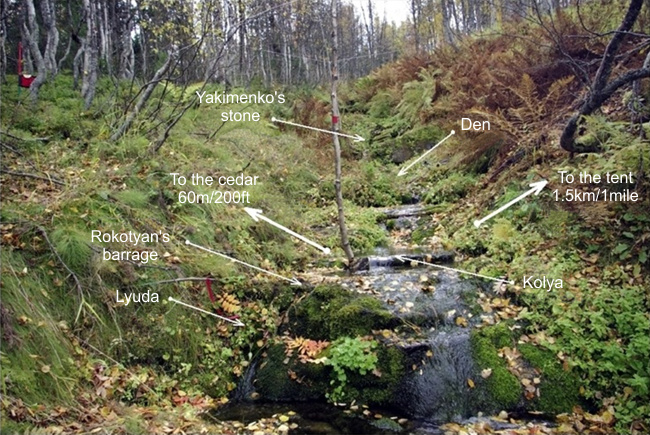
The red mark on the pole is 1 meter from the base. The distance between the Yakimenko stone (P4 according to KAN-2011) and the Rokotyan dam (exp-2009) is 11 meters.
The level of snow in our time, it seems to me, was according to the top edge of your photo. In the photo of our time, the snow level should be counted from the roots of the cedar, where there was almost no snow, and horizontally (you are right about this) until you meet the right (in the photo) bank of the stream. This is clearly visible in many photos. For example for this photo the photographer stood almost above the den that had not yet been excavated.
If you look along the stream "in profile" of the snow cover, then where the guys were lying there was about half a meter more of it than where Lyuda was lying. And even higher, towards the den, it was already more than 2.5 meters. Apparently, two processes were at play here: the prevailing wind rose, the unevenness and intensity of melting. Then again the thickness of the snow cover increased to almost more than 2 meters.
–
It’s so not obvious that we drank water from this stream, just downstream! There was a lot of snow in the area of future excavations; two-meter probes did not reach the ground. Almost every morning there was an operative near the cedar tree and we, not paying attention to the cut off tops, went to carry out Ortyukov’s orders. The bad thing is that we worked out the task for the next day in the tent in the evening, and in the morning Ortyukov formulated a specific task for everyone. And in the tent, as a rule, they discussed where we haven’t been yet, where else we need to work with probes?
–
I remember exactly that the things were in different places. The first to be found were the half-legs - they practically lay on the surface, and were discovered even before the excavations began. The sweaters were discovered much later. I either don’t remember who, when and how I discovered it, or it was done when I was distracted by something or someone. Or maybe they didn’t attach much importance to it, so it didn’t stick in the memory (back then there were sensations every day - more than enough!).
The excavation - the one in the picture - is an intermediate stage of the same excavation (as far as I remember!). It is possible that the floor of the sweater was discovered precisely at this intermediate stage of the work, somewhere at a depth of half a meter.
We found the beginning of the path of branches right on the surface, near the cut tops, and used them to guide us in which direction to dig.
–
They stand in the place of the four. The boots are not waterproof and there is little water. They stand on rocks (apparently). I know only one thing for sure - there were two excavations - the flooring and the corpses. By the way, the flooring for searching for corpses was only a good guide, and the guys were found by chance below it. If they had been lying above the flooring, we would have floundered for several more days.
The excavation site with the flooring is in the background. Of course, the photos are bad.
–
All this lay far away from our usual routes. How far? 100 meters to the left of our paths. This is clearly visible in many photos, for example this one! The excavations were in a nearby hollow, see in the background.
–
Besides Lyuda, I remember in the slightest detail how Ortyukov discovered the notebook - no one remembers (I asked Mokhov!), but I remember! And except for Valentin Yakimenko, no one believes this, since it is not mentioned in any document!!! I suspect that Ortyukov appropriated it for himself on the sly (for some reason).
Weather
Vladimir Askinadzi :
Hello, Galya! Apparently, you are interested in the wind rose of that area at that time? I'm a bad informant on this part. It seems to me that it was blowing from all sides, even from below. There were very windy days when there was no desire to go out on the route, but Ortyukov was adamant in his decisions - army school.
Dyatlov group trek
Galya! Neither then nor now did there exist any general rules on how to behave on a hike. I don’t know how it was with Dyatlov, but I always, right up to the violation of the movement schedule (later I will be justified when I bring everyone alive), considered my main concern to be providing the group with a warm, dry overnight stay. Comfortable sleep made it possible to fully restore strength overnight, no matter how difficult the day was.
In the initial period of woodpecker studies (59-60), I criticized Dyatlov and saw many of his mistakes. Many (Axelrod, Bartolomey, Yakimenko, etc.) justified Igor to make a cold overnight stay at the pass as an experiment that unexpectedly ended tragically (!!). I have always been a supporter that it is necessary to experiment on weekend hikes, and on hikes, especially those of the highest category) there is no need to experiment and subject the participants to even additional difficulties.
Therefore, it is very difficult to answer your questions. You are right, without a fire, and, therefore, there was no opportunity to dry outer clothing, this is already a precedent for creating an emergency situation. Although it should be noted that canvas items (storm boots, shoe covers, etc.) dry very quickly, even with a small fire. I did this on Kola, when even when writing my diary it was enough to completely dry my trousers and rain jacket.
I don’t know if I answered your question, but I, like you, in many ways do not understand the reasons for making certain decisions of Dyatlov. Diplomatically, I said (lately) that if I were in the same place at the same time, I would make the same decisions as Igor. Of course, I was lying.
Galya, you know, this is the first time I’ve heard that for some reason you need a raincoat - a tent! Especially in winter. They probably still take the most stupid things, and then on the route they suffer because of their uselessness.
Separate from the male part of the group at night? In my memory, there were no cases of girls being offended during a hike. Vice versa! And on summer, and especially on winter hikes, girls were always given the most comfortable places in the middle of the tent. If they needed temporary privacy, they had the entire tent at their disposal. There have never been any problems with this!
In winter, you could put it under a tent on skis to protect yourself from melting snow at night. Not so much as thermal insulation as waterproofing. But then this cloak - scarf should be public equipment and taken as directed by the leader.
All my reasoning is an attempt to save the group’s reputation and present possible options for using such useless equipment.
All this is understandable if you imagine the poverty we lived in then, and established recommendations and rules for hikers had not yet been developed. Everyone invented whatever came to mind. Once (due to my oversight) on a water trip, one of the participants took my boots (!!), the equipment of mountaineers. I suffered throughout the whole trip. Our traditional shoes are two pairs of sneakers. One couple could not stand the month of the trek. I had to share my sneakers with him, but he never took his boots out of his backpack, and their weight was at least 2 kg.
–
Definitely, Dyatlov made sketches in order to later put them in his report. This is what all leaders did and, I hope, do. He simply doesn’t need the crocs for the storage shed; it’s enough to make some nicks or other marks, because once he uses this storage shed, no one needs these crocs.
For a future report, he could draw outlines, for example, the forks of the path to Lozva and Auspiya. I could also draw croques on other landmarks. Anything will do for the report! If the exit to the pass is not clear, I could draw explanatory directions to the pass. And if the solution is clear, then no one needs such money.
–
You are very right! Igor's diary was written by not entirely experienced hikers (in terms of its information content). The general diary is written for other managers who decide to either go this route, or as information for comparing alternative options. Moreover, Dyatlov made the first ascent. There is nothing in the group's diary for such readers.
According to my diaries, and these were detailed directions of the rivers (I’m not bragging, it happened!), other groups went and said that no more documentation was needed. I also made many first ascents, so I had the right to give my name to nameless rapids. It was nice when, 15–20 years later, information accidentally surfaced that the Shabash rapids (on the Katun River) had been passed safely. And we gave the name to this threshold a long time ago. And there were plenty of such cases.
But the experience of writing informative diaries comes very quickly.
I left the most important thing for last. If the leader does not leave one copy of the approved route book with the controlling organization, then the route will not be counted towards the group!
Both the respected Gordo and the no less respected Slobodin (Chairman of the trade union committee of the institute) burned out on this.
But after the tragedy with the Dyatlov group, all hikes of the highest category of difficulty (no matter what specialization) were approved only in Moscow! And they were controlled by local tourist organizations and Moscow. The manager sent two telegrams about the end or forced change of the route to two addresses.
What was it really like? The leaders honestly included the recommended standards in the route books, otherwise the burocrats asked so many questions that sometimes they had to redo the application documents anew. Knowing that no one would check it anyway, the leaders themselves made decisions about what and how many products to take. 1200 grams per person per day of dry foods! Yes, these will be heavy backpacks! According to documents, 3 kg of salt were purchased by Dyatlov! Galya, can you imagine how many days this amount of salt would last a family, even if the family consists of 10 people? For my family of 3 people, 1 kg of salt is enough for six months. Considering that hikers only need salt for breakfast and dinner. For two weeks, how much salt would you buy yourself? So Dyatlov, too, said one thing, but took with him something else, both in quantity and in composition. You need to know these specifics of those days and correct the information!
Therefore, it is a mistake to count days by the number of products.
In Zina's diary (she is the most conscientious informant) during the preparation of the expedition, when all the products were collected in her dorm room, nothing is said about the food supplies.
–
I did not talk about my position that the "killers" would have had nothing to do with it if it were not for the abundance of gross mistakes of Dyatlov himself. He ruined the group!! With "variations on the subject". Half the group could definitely have been saved. But I had a defensive reaction, I didn’t want to badmouth the "icon".
I already drove Maya into a state of stupor when I wrote to her long ago that, if we discard the "variations on the subject", then the group was doomed by Dyatlov (!!!). And if we are not being disingenuous, we must stop looking for the lost item under the night lamp, since it is brighter there, and close the topic. There will be no documents that clarify anything new. Perhaps new telegrams will be found, like the one that Natalya Varsegova published in February. Such "news" does more harm than good.
That's why I practically stopped participating in the Dyatlov case research.
–
Whatever functionary Maslennikov may be, this is none of his business. The leader decides who to take with him. The Routing commission formally looked at whether the route was prepared, as such, or they were going without knowing where! This was the responsibility for the approval. There shouldn’t be too many newcomers in the 3rd category, but again, everything was up to the leader. The Routing commission intervened only when certain violations were too obvious. Zolotaryov's participation was not an obvious violation to Maslennikov. Dyatlov could easily explain if there were questions. But, I repeat, this was BEFORE the tragedy.
–
I can tell how I prepared for a trek as a leader. Before setting out on the route, I announced how much everyone would receive from the group's load (food, equipment). As a rule, it was somewhere around 10 + 10 kg. The rest is the weight of personal belongings. So everyone figured out how much and what to take. Carry a 30-kilogram sidor or 50. I don’t think that Dyatlov would dictate what to take from clothes and what not. On winter hikes, it was mandatory to take a padded jacket and that’s it. You are right, it is needed not so much while moving, but for work in the camp, and it was placed under you at night. But sometimes they were used while moving - everything depended on the frost. The storm jacket provided good protection from the wind.
–
They couldn't have survived without shoes. In the best case, only Zolotaryov, maybe someone else, would have been saved by undressing the corpses.
–
In 1959 the people have not yet been freed from Stalin's embrace! If these are indeed footprints, and not a trick of nature, someone was there before the searchers. Judging by the state of the tracks and taking into account the type of weather (constant wind of varying intensity), the one that left them had passed there at least a week before. Why no skis?? This was his auxiliary route. He saw a cedar and decided that spending the night here was better than in the small forest. Apparently he didn't know the area well. But, seeing the corpses, he left. Maybe he decided to go to the second cedar. You need to look for an overnight stay somewhere nearby - no further than 100 meters up the slope from the cedar or near a second cedar, to which little attention was paid. Not wanting to get involved with the Soviet prosecutor's office, he most probably had nothing to do with the demise of the group.
By the way, there was a fairly dense forest further there in our time, without reference to the conversation about the tracks, I don’t understand why Dyatlov’s group was left practically without a leader. There was no connecting unit. It seemed like everyone acted without seeing anything or anyone around them. As for the footprints, these are thoughts out loud, nothing more!
–
According to the unwritten rules of mountaineering, which have been observed since begining of times, if the trek is not traversing the peak (after which the route continues), the group always climbs lightly. If a leader drives the entire group with full effort to such a peak, this is either a completely incompetent leader, or a sadist, but I have never encountered such people in my practice. By the way, the same rules apply to climbing.
Further. The whole group never participates in the ascent. Someone, or better yet two, should remain on duty at the camp to greet the climbers with at least hot tea, or better yet, a hearty dinner (this is more important in winter!). Dyatlov should have understood this!
I think that after their last overnight stay, Igor expected to make another one under the very top in order to have time to complete the ascent on a short February day. There are a lot of details that support this. In one day from the place of the last night, Dyatlov could not have climbed and returned - there would not have been enough daylight hours.
In my understanding, Dyatlov needed at least three days to climb and return to the cache site. After all, it is also necessary to take into account that they would have to build a ski track, at least to Otorten.
We went, firstly, previously rested, and secondly, in our time the day was much longer than in February - more than 14 hours!!! Thirdly, in our time there was a very strong crust and it was very easy to walk. Besides, we walked without backpacks. Well, the last argument in our favor is that Stepan Kurikov led us, and he knew these places like his own, so we didn’t get lost, but walked purposefully, which saved time.
I didn’t see this "chum", perhaps because we were led by the shaman Kurikov, who deliberately avoided it, but later I had information about it. There are a lot of such places of worship not only among Mansi. In the Sayan Mountains and Altai, we often came across, even in remote places, odo trees hung with colored rags.
Of the search participants, including soldiers, none had been to the summit in our time.
To your last question, "how long, in your opinion, could it take to climb Otorten, approximately from the tent site of a group of 3-4 people without backpacks?" I would like to answer: "no time at all!" It simply makes no sense to make a base camp at the site of their last stop.
–
So that the hike is not a tedious and exhausting work of wear and tear, so that the hike is remembered with joy for a long time (otherwise, why go at all?), several conditions are necessary:
1. people, going out on the route the next day, should be well rested;
2. after a day's march they should have a good dinner and, if possible, a comfortable sleep;
3. the leader, when analyzing the day in the evening, should not publicly criticize anyone (especially if he does it rudely), maintaining an atmosphere of friendship in the group;
4. etc.
Therefore, I definitely would not go out on the route, knowing that I only had a couple of hours of daylight (unless, of course, there is force majeure). In any case, I wouldn’t spend the night on a deserted slope, seeing that the forest is just a stone’s throw away, especially in winter. We need to give the guys the opportunity to dry off, get a hearty hot dinner, and just sit by a warm fire, waiting out the snowstorm and frost, even if this has to be done in complete darkness. Under the trees, you can put up a tent on a thick layer of spruce branches, and not on bare skis (on the issue of a good rest).
And, in general, the main task of a leader is to constantly think about the well-being of the group, and not about the route and deadlines. The route and deadlines are secondary! If you need to take a day off for one reason or another, even in violation of the deadlines, you need to do it. If the group returns alive and well, everything will be forgiven to the leader, and the guys will continue to strive to go only with a reliable, proven leader.
–
He had an option in reserve (if this was my route) - after climbing Otorten, return through the labaz along his own ski track, which could significantly reduce the backlog by the final date, and not by the intermediate one.
–
Galya, when preparing the trip, especially the first ascent, an error in calculating the schedule was not punishable. With the quality of the cartographic material, with the confidentiality of information in everything, it was very difficult to guess what actually awaited you on the route. Therefore, if you return your memory to the end of February, then it will be clear to you that they were monitoring the delay to the deadlines, but were not particularly worried. It was only later, two years later, that they began to treat deadlines strictly. But still... Such a case happened to me. In 1962, I was preparing for rafting on the Kazyr (Sayan) River. Due to the nature of my work, I often went on business trips, including to Moscow. There I got the information I needed. In Lenin there was a multi-volume "Water Resources of the USSR", published in 1939. This is a description of all rivers, including their tributaries. Kazyr is a tributary of the Yenisei. The description, as a rule, made it possible to navigate the pace of passage of the river.
The next year I began to prepare rafting on another Sayan river - the Kizir. As always, on my next business trip I went to Leninka. It turned out that this multi-volume work had been classified!!! It was open for free use for a quarter of a century, and then someone got a pang and decided to classify it for 25 years. This is how we lived! The main source of information were hikers who had once visited the area. What if it’s a first ascent? Who to look for?
Therefore, I do not think that this problem bothers Igor very much. The only thing to worry about was whether there would be enough food until the end of the route.
–
The money was beggarly, so they gave it like a beggar - on the principle of "as much as I can". As a rule, this money was not enough for half a ticket for each person.
I don't think the cold overnight stays were planned in advance. I'm not a skier, but planning ahead for an emergency is putting the group in danger. If you want to develop your ability to survive in cold overnight conditions do it on weekend hikes, experiment until you turn blue. Most likely, this is an unsuccessful impromptu by Dyatlov. "Cold" and "hot" overnight stays were never taken into account when confirming the complexity of the route. A number of overnight stays in field conditions was planned.
You know, Galya, I have a lot of comments about how Dyatlov conducted the first part of the route, by the way, and not only me, but it was decided not to discuss this publicly, since nothing can be corrected, and it did not affect the cause of the tragedy in any way. Medical certificates for approval of an expedition were required, especially for Dyatlov’s group. Without a complete set of documents, he would not have received a penny from the trade union committee.
–
How they managed to hide Yuri Yudin's illness is the art of Dyatlov himself.
Moreover, the more difficult the hike, the more doctors it was necessary to run around. In the same 1959, we went to Altai, so on top of everything else, we were forced to receive three injections against encephalitis. You don't need to explain how painful they are. One of my friends fainted after the third injection. The head of our student clinic (there was one like this at one time, then it was repurposed into a district-wide clinic) was the one who told me who to go to.
Dyatlov received some money for his expedition from the trade union committee. Without a full set of documents, including a medical certificate for each with serious seals, they would not have given him anything. How he got it is his art of seducing the head physician. True, Gordo was removed from his post for connivance (in other matters). But then they didn’t pay attention to it. After all, Yuri Yudin was alive. If he had died, I think the case would have been blown out of proportion.
–
We will never know their mental state at that moment. From common sense, the Dyatlov group have made plenty of mistakes. Their entire last day is a heap of mistakes and absurdities. But, if this is a deliberate murder, as Tumanov claims, then these mistakes are understandable. But you can see it when you’re sitting warm and well-fed at home.
Searches
There was no talk about any equipment in front of us. Someone would have remembered if it existed and was used. And even after almost 2 months of searching, no one saw or heard about it. Any power sources (radiation ones included) have a service life. Some are small, others are larger, but always limited because of the active substance that consumes. This means that you need to constantly keep track of the remaining work resource in order to change sources in time. In other words, you need to create a special service for this. And no one ,emtioned anything like that.
–
Academic leaves have never added knowledge to anyone; if you did not acquire it due to laziness in previous courses, then in the 4th… 5th year it is pointless and useless to get one. Everyone treated academic leave differently. For example, I had a very painful time getting used to the new team, so as soon as I imagined that I was losing friends with whom I lived for 5 years in the same room, I began to feel a slight panic. Others may not have felt much discomfort when changing teams.
I doubt that Zinovyev and Sogrin were promised academics, although, as always, I do not insist. What is the fundamental difference between our shift and others? The participants of all shifts, except ours, were volunteers eager to get involved in the search, and there were quite a few of them! Therefore, the management did not need to encourage or buy them in any way. Moreover, for this reason, shifts changed every 10 days. By the month of May, the number of willing volunteers had diminished - there was a session nearby and either passing "tails", which meant life without a scholarship, or sitting at night to catch up. Of all the leaders, only I was called to the party committee and almost ordered to assemble a group. They told me that we would be the last group in the search, so we would stay there until we found the guys. And everyone was sure that we would find them when all the snow melted, i.e. we could live there until the end of summer. Academic leave with retention of all benefits was the payment for such an assignment. The other leaders were appointed, in my opinion, by Gordo himself.
Regarding your question, I don’t know how and why the Dyatlov group members lay like that. By our shift, only the designations of the places where they lay remained. The tent was marked with two ski poles. The bushes where Igor lay were, in my opinion, marked with a rag. But Rustem’s resting place was not indicated. They knew that there were corpses under the cedar tree. But we didn’t ask each other any questions about why they were lying this way and not otherwise.
–
I think that after discovering the tent, the searchers went down to the forest, to the firewood, to the fire, and accidentally discovered the two Yuris. This became the main thing in determining the search area. And when they found three on the slope, all doubts (if any) about the correctness of the chosen search strategy disappeared altogether. Then everything began to be confused by a stupid doubt: had they gone to America? This cost at least two shifts of fruitless time spent. This hooked us for several days. The problem with America was first highlighted in a whisper, and only when a 2-month search did not produce results, apparently out of desperation, the issue with America began to be exaggerated. But these are my assumptions.
–
What is strange to me is the fact that none of the leaders of this diary then read it. The search was unsystematic all the time. Otherwise, how can we understand that Maslennikov, having clearly indicated the place of search for those who remained, wrote that there were no traces of them in the immediate area, and we (it seems like Blinov’s group too) continued to be forced to look for traces far from the tent.
Maslennikov draws attention to the felled tops of the fir trees, saying that there is no need to move far from them, they are "sleeping" somewhere nearby. And yet, for almost 8 weeks (March - April) we went in circles. And, most importantly, detailed information was not transmitted from group to group - only what the group leaders managed to convey during the time of the landing, the new arrival and the departure of the replacement!
Apparently, the goal was not to find the guys, but to show the authorities (in Moscow) zeal in the search! Such display was the norm of behavior in party organs at that time!
If they had listened to Maslennikov’s conclusions, in 8 weeks they could have plowed this stream almost to a height 880! I think that on the third or fourth day we would have stumbled upon the corpses already. Apparently, the stupid idea that they went to America (!!!) kept many people awake!
We met Kirill Bardin in 1959 in Altai and did not know that we both participated in the search.
–
You think very well about the methodology for conducting search work in 1959. We did not have not only professionals who understood excavations, but also an investigator who would constantly monitor and record new facts. In one of the interviews I already explained how we worked. In the evening after dinner, Colonel Ortyukov gathered a small meeting to sum up the results of the day and adopt a work plan for the next day. As a rule, these operations were attended by the Kurikov brothers (guides - Mansi), myself, as the leader of the student group, and Nikolai, the leader of the group of soldiers. Sometimes Ortyukov conducted operations only with the Kurikovs, without Nikolay and me.
In other words, everything was completely impromptu. There was no strategy or a plan. There were only tasks for the current day! We'll find it - okay, if we don't find it - we'll look tomorrow!
I am writing this so that you understand the situation of those days.
I'm not entirely accurate. Of course, there were two versions circulating: rocket and avalanche. Everyone who personally participated in the search did not really believe in the avalanche version, since there were no traces of it, but the rocket version was not only now the only one, but also the most popular. The government itself, having strictly classified the beginning of the search, provoked this version. And we believed in it, although we had doubts even then: a rocket, even if it exploded in the air, could not scare grown ups out of their minds. But then there was nothing else, and the investigation materials were still being written.
That's why we didn't do any science. They plowed like moose all day so that they could sleep dreamlessly at night.
Often we, the participants in the search, are reproached for not looking at this and not measuring the other. It would have been necessary to determine even then that Dubinina had no tongue, and Zolotaryov had several broken ribs. We didn't have such a task. Our task was to find the corpses and hand them over to professionals for examination. Of course, over time, when the investigation materials became available, you reproach yourself in your heart for not watching this, you should have watched this too. Alas, the train has left the station.
Is this only the case with labaz? After all, there were no photos or other very important aspects of the search. All the photos of the latest events are photos of our group, mainly Mohov, and a few of him, mine and my other guys, since there was only one camera for the group. If we didn’t have a camera, the history of Dyatlov research would be completely different, if it existed at all! The official bodies only had photos from the Dyatlov group cameras, and, perhaps, of the initial period when the tent was discovered. But I doubt this too. It looks like these photos were also taken by students.
Look at the photo where the bodies are being extracted. All the authorities are standing in the background, including Ivanov and Vozrozhdenniy. They stand and watch the process indifferently. And after that Vozrozhdenniy exclaims that the corpses have no injuries! Yes, he saw them from afar! It would seem that what a normal investigator leading this case should have done at this time? Poking around with a camera, taking pictures of every little thing, so that later, in the office, you can figure out what’s what. Were you hoping for the results of the morgue? But one complements the other. How much additional information did enthusiasts pull out later by comparing these photos?!
Don't pay attention to Maslennikov's information. This is a vestige of Soviet power, when they gave birth to rules and instructions that no one needed. These "activities" were in vogue back then. The "writers" of these masterpieces themselves understood perfectly well that no one adheres to them. But, giving birth and expressing them was always a desired process, even if they understood that they were stupid!
–
I am sure that the pine trees with the tops cut off were only in ONE place, and not as Borzenkov claims. From this place the "rag" is clearly visible. From the stream where the search is going on (from the second "fictitious" place) the rag is not visible.
–
1. I didn’t pay attention to whether there was one crew flying or several. For me they all looked the same, like the Chinese. The corpses were taken away by one helicopter and only the next day, so my students, Tolya Mohov, Kuznetsov and Suvorov (I don’t remember if Fedorov was there too?), were forced to spend the night at the pass, guarding the corpses from animals. I didn’t spend the night with them, because Ortyukov was supposed to have a scheduled operative in the evening, but it didn't happen, Ortyukov was not in "shape".
2. After sending the corpses, we began to dismantle the camp. One tent weighed quite a lot. All equipment and people were evacuated every day until May 13th. And the people, not counting me, were 5 soldiers, 4 students, two Kurikov brothers, a dog handler with a dog, a radio operator Nevolin and Ortyukov. If I haven’t forgotten anyone, there were 12 people and a bunch of government equipment for which someone had to report, so they didn’t want to throw anything away except broken skis. There were at least 100 kg of food left, since there was an indication that they would no longer change us. We'll stay until we find all the bodies. And everyone was sure that we would find the guys when the snow melted.
3. Not only I, but Suvorov and Mohov also remember that Ortyukov threatened the pilot with a pistol. They remember that I calmed him down. And the fact that Victor Potyazhenko does not remember this episode means that either there was another crew, or the man forgot.
4. Victor Potyazhenko describes in sufficient detail the initial period of the search, which I did not witness. But, judging by the subsequent information, one can expect that its reliability was, alas, not 100%. Judging by his age, he is 8-10 years older than me, which means he is now 87 years old. He shouldn’t remember anything at all, but he’s still trying to portray something. Let's forgive him for this weakness, he doesn't want to leave forgotten by descendants. And during almost three months of living in the taiga (albeit with interruptions), Ortyukov "went wild" a little. This was not his element.
–
I read somewhere a description of two wounds on Dubinina, one of which I mentally attributed to myself - wounds on the neck and back of the head. I tried to remember to forward it to you, but I couldn’t immediately. I’ll find it, but to do this I need to look through my entire archive, I’ll definitely send it.
Secondly, I clearly remember that on the hook there was a piece of meat the size of a thumbnail. With any other hit, I would have pulled out (with difficulty!!) a piece of clothing.
Thirdly, I remember we dug up Lyuda from her head, not from her feet. I instinctively stuck the probe perpendicular to the surface of the snow, and in this place there was a hill, and we dug in the direction of the probe. If I had struck vertically, I would have hit, at best, one of the legs.
–
How did I prepare to go on a search, even though I really didn’t want to?
In addition to the information that was circulating around the institute, and especially in the hiking club, I talked with many guys who had been there before us, and not only with the group leaders. Therefore, when we were dropped off by helicopters and had a detailed conversation with Yuri Blinov, who, like me, was opposed to our arrival, I was quite well versed in all the nuances of the problem. But sometimes I was little interested in the source of information. It’s good for Valentin (Yakimenko - ed.), I forgot something, met with friends, had a brainstorming session, and came to some kind of agreement. I am alone with my catastrophically aging memory. To you, as a doctor, I don’t need to explain this!
And yet!!
I knew then that they had found group's diaries, photographic films, etc., but I didn't see them. I knew something in the retellings, but these were some short fragments. I knew that Maslennikov was guided by entries from the diaries in his search. Therefore, I will not insist that they returned to their previous overnight location. Maybe the generally accepted version is correct. Although the version that they returned precisely to their previous overnight stay did not raise any objections in our time. But there are entries in the diaries, and challenging them after 55 years is a hopeless endeavor.
–
I don’t know where I got this information from, but during our search there were rumors that Dyatlov went to the pass twice. The day before they had reached the pass, but returned to their previous camp at the labaz(?). And only the next day they went out again to their last overnight stop. I never mentioned this fact anywhere, but I haven’t forgotten. Someday I’ll pluck up the courage and ask Valentin (Yakimenko - ed.) in a private letter, maybe he’ll remember.
If Dyatlov’s last camp was at the labaz, then Maslennikov’s camp was to the west of it. There was no search camp at the labaz, which confirms the absence of any traces of searchers staying there for a long time.
–
Reading your letter, I found myself back in 1959! From the very beginning of the correspondence with Maya and until the last interview with Natalya Ko, I said that when we took out Lyuda, we did not turn her face up, but laid her aside face down, covering her with random rags. And no one asked me a question, not even the inquisitive Maya, but, in fact, why? What, it wasn’t interesting to look at the condition of the exposed parts of the body? I would not have been able to answer these questions then. I didn’t understand why!
And only after reading your letter, I clearly remembered our general state. That same psychological discomfort from the first fact, when you know everything in advance, and you don’t want to make this “everything” even more terrible. And when they took out the rest, they calmly, at the request of the superiors, turned them over, gave them the opportunity to look at them without experiencing any discomfort, and calmly took pictures. In general, everything was done more calmly. And when they packed Lyuda into a bag, they did it more calmly. Thanks to our subsequent peace of mind, there are a sufficient number of photographs.
–
There really was less wind under the cedar. Maybe that’s why we often spent our morning five minutes under the cedar tree. But there were probably enough quiet days in two months. Therefore, the snow cover there was not only as a result of supercharging, but also fell calmly from above.
–
This is a Google map of the area. Filming took place in 2013, i.e. newest. I came to this area, moving along up Lozva river. I reached the labaz area (in the first fragment - lower left corner). Above there is a pass and up to the right there is a forest with our cedar. Pay attention to the scale of the map.
Then I gradually increase the scale to get closer to the cedar.
In the second fragment, streams, tributaries and vegetation structure are already visible. Our stream is right in the center of the map. Is the scale one cm? 60 meters.
In the third fragment, I took “our” stream to the left end of the frame, but left its confluence with the Auspiya tributary in the upper corner. Here the scale is already 35 meters in one cm. You need to look for cedar somewhere 2 cm from the stream and 10 cm from its confluence with the Auspiya tributary.
If they managed to find the place of a cedar on a completely blind map, then I tried to make the task easier for them. To make it easier to work, I placed the stream in the center of the frame. Individual trees are visible. You can find a "half stream" and a "quarter" stream, and whatever you want.
Go for it, ma'am!!!
Otherwise, on a completely blind map with filming from ten years ago (the area has not changed much since then, but the technique and quality of filming have changed significantly) he is trying to make the discovery of the century (KAN praised him too much!!)
Karelin is a very mysterious person. This is probably the only veteran with whom I cannot communicate. I think it's not just me. Apparently, like Zinovyev, he is quietly writing something that only he himself will read.
A couple of days ago I spoke with Valentina Poluyanova on Skype. She is perplexed by Zinovyev. He has some materials on Poluyanov. Valentina asked him to send them to me, and he replied that he had no time now - he was writing a book! So Valentina asks me what’s wrong with Zinovyev? Her request takes a maximum of a couple of hours, and he has been writing his book for more than five years, and only I know this, since five years ago he asked me for all the materials that were available on Otorten, explaining that he was writing a book!!!! In fact, probably more than five years.
Not all! Only the area from the cedar to the tent and labaz was carefully considered.
The second cedar had only occasional visitors - at best, they were looking for a toilet.
–
Did I accidentally not tell you how long it took the helicopter to fly from Ivdel? In my opinion, no more than 35-40 minutes.
–
Regarding the knife, allegedly Krivonischenko's.
Ivanov deliberately misled everyone. What is it like to find a knife in a stream? This is a whole event! It is necessary to presumably determine the search location, but for this only a small section of the stream was open. The rest of the creek was covered in snow. Further. Even if someone guessed to remember about the knife, it was necessary to dress the searcher(s) appropriately so that he would not get wet, so as not to catch a cold. The depth of the water in the stream was at least 20 cm, which means that one or even two searchers, helping each other, would have been fiddling around in the icy water up to their shoulders for several minutes, or even hours. For what??? There was none of this. In my first interview with Maya Leonidovna (Piskareva - ed.), I said that all the authorities who arrived when we found them behaved like excursionists - they stood, watched and talked peacefully among themselves. They were not only interested in the knife, they were not interested in anything at all! But such events are not done voluntarily on one’s own initiative!
What Tolya Mokhov once voiced, I think that this is also not true. He did not find any knife or sheath for it.
I don't think anyone searched after us. Firstly, the case file was already practically completed as required. Secondly, we assembled a camp and after us it took time to set up a new one, or to live in real field conditions was posible no more than a couple of days. What additional things can you find during this time? And why, if a closed case suited everyone!
–
I think that Ortyukov exaggerated somewhat, although they worked with probes, but only where they reached solid ground. It was pointless to work with 2-meter probes when the snow thickness was significantly greater than their length. And what kind of traces can we talk about if we only had two standard emergency probes with a diameter of 20 mm, and the rest were scraps of 10 mm wire? What marks could the thin wire leave? And, if there were traces, we did not pay attention to them. We knew and remembered the areas that we probed, and this was enough for us not to explore the same area again.
–
How did the epic search begin? We knew Dyatlov’s deadlines and never considered his lateness a possible tragedy. They believed that there would be enough food for another three days... a day. The food should run out yesterday, but a little more and the group will show up. There was no nervousness or expectation of something bad. Being late to deadlines has always been considered bad, but not fatal. After the tragedy, sports tourism was banned for almost two years. In Moscow, an initiative group, which, by the way, included Kirill Bardin (he was on the search along with two other Muscovites), intensively developed the basic provisions on sports tourism. It was necessary to go through approval in a whole bunch of offices (a typical socialist situation), and for this it was necessary to spend more time than developing regulations. But the people continued to hike without approval. This agreement could have lasted for a long time if corpses had not started falling en masse over these two years.
This frightened the authorities and the provisions were urgently approved by the All-Union Central Council of Trade Unions. It was written there that if the manager was late to the deadlines, he could face punishment. If the group was more than a week late, a search helicopter was sent. If it turned out that the group, due to laxity, did not inform about the end of the route and decided to rest somewhere after the hike, then all costs for the helicopter, etc., were at the expense of the group. Therefore, when analyzing a particular situation, one must keep in mind when it happened, before or after 1959.
–
No, there were no flares during the search. There was no need for them. By the way, once, while in the Sayan Mountains, I took several flares from the the city’s civil defense. I thought that they would be needed during the passage (we were going to go with two rafts along a difficult river). Nonsense! We never used them.
–
After the search was completed, all the searchers gathered in the dining room of the 5th building (there we first argued with Moisey Akselrod about his avalanche version). So, about 100 participants gathered there. At best, I only knew a few (!) group leaders. I didn’t even really know Yudin at that time. In 1959, Sergey Arzamastsev (R.I.P.) and I went to Altai and had no idea that we both participated in the search, although he was in the group of Yuri Blinov, whom we replaced! This was the situation with who knew whom.
Labaz
Setting up a labaz in the current situation is quite natural; as they say, the solution was on the surface. In general, if the final destination of the route involves returning along your own ski track, or along a route very close to the original one, several cache depos are set up. But all this is at the discretion of the leader. The structure of the labaz clearly shows that the group, having reached Otorten, will have to return, i.e. – Dyatlov decided to make a radial approach, and it’s right! I would make the same decision. Moreover, I would take only volunteers to Otorten, and leave the rest in the base camp. This would not affect their qualifications. One can only guess what Dyatlov wanted to do.
Galina Sazonova :
Now various smart people are trying to figure out how many skis were left in the labaz, one or two. According to the case file, these data also differ, so known photographs are examined under a microscope. I rather support those who believe that there were two. What we have? 9 people - 9 pairs of skis + 1 spare (it is also visible in some of the photographs). How many pairs of skis were under the tent is a mystery. Because the first search immediately pulled them out and put them to use - they gave them to the guides and began to mark the places. But if there is one pair of skis in the labaz, then it turns out that the tent should have 8 + 1 skis. Why do they left behind a whole pair? Plus "my ownerless backpack" in the photo of the morning, at the last camp. I asked you about it, could the group leave a fully packed backpack at night, how many meters from the tent, and whose is it if things and a blanket cannot be pulled out of it? And now, in fact, at the last camp, where the labaz is, we can combine one backpack and one pair of skis. This is one person's equipment which is missing. And the late start could be connected precisely with this - they are waiting for him. And they don’t go far - they wait for him to catch up. Zolotaryov left the group the day before. 31st in the evening. And his skis remained, apparently, stuck in the place of the old camp, which he knows. And his boots are wrapped in wire, like crampons.
Vladimir Askinadzi :
The question with skis is fortune telling on coffee beans, although it projects well onto the problem! But for some (like Helga & Co) it’s a great time!!! I remember their long discussion on the topic, why did a candlestick found somewhere have a square frame (bottom)? One and a half pages on the forum!
As for throwing away part of the approved route, this is not yet a fact. He took quite a lot of food with him (several bags of crackers, ham, etc.). By the way, we should clarify what he left in the labaz and what was found in the tent? Do you have such information?
Investigation
You know, Ivanov did not call me for questioning with a report, but on the day they arrived (May 5), he talked to me in a friendly tone. I only remember the conversation itself, but apparently there was nothing alarming in his questions. At the end of the conversation, he promised to give me, as an exception, a set of photos from the Dyatlov group’s films, but he didn’t keep his word.
Nobody asked me to sign a non-disclosure.
–
No one felt the tragedy. Everyone calmly went about their business. Even we, who were participating in the search, did not see anything extraordinary in the event. Maybe because at that time everyone understood the cause of death. We were "hooked" on the rocket! It happens to everyone??? Well, bad luck guys. And when everything is clear, then there is nothing to discuss!
Already in May this incident was not discussed anywhere. What to discuss?? Accident! The elements!! This could have happened to everyone, if they had been there then! True, there was hope for the reasons to be published in some local newspaper. We waited, waited and cooled down!
Even Boris Martyushev did not mention the Dyatlov group in his report. He mentioned me, a slob, that I drank vodka with my friends and bawled tourist songs in the dorm after 12 o'clock at night (by the way, he was present at the same time), but he didn't remember about Dyatlov's group! I.e. violation of dorm rules was already by that time a more significant event than the death of 9 people!
As for the behavior of Budrin and Kolya Popov, this is from the same opera. In addition, it was possible to go on a search only when the authorities agreed to it. There were too many people who wanted to take part in the first 3-4 shifts. This was later, when everyone was convinced that while there was such deep snow, the search should be stopped until spring (at least until May).
In July 1959 we went to Altai. There were three searchers in the group from different shifts: me (sixth shift), Sergey Arzamastsev (fifth shift) and Volodka Belyakov, who died a year later on Kodar. And we never (!) remembered the Dyatlov group. There was nothing to discuss. Found, and case closed!!
It was only later, when the investigation documents were made public, that unprecedented interest was revived! And it was revived by those who were born 10-20 years after the event!
I remember how my position changed. This is clearly evident from my early correspondence with Maya. If at first I was an ardent supporter of the rocket, then after a couple of months I no longer objected to crime. Maya did not publish everything from our letters.
So don't be surprised by anything!!
Peculiarities of the era
Relationships
After the winter session of the 6th year, three of us were sent to practice, and later to work, in the nuclear city that my parents built. February is cold. Naturally, no one met us at the checkpoint. Dark. I was the only one who had a home here. Without hesitation for a moment, I suggested getting to my parents. At the same time, I did not give them a notice. We arrived just at the end of dinner. My mother raised five children, so two more could not increase her worries. She greeted us as if we had recently left and returned! Behind a bunch of motherly questions, dinner was quietly prepared for us. And the apartment was two-room, my parents lived in one room, and all the younger children lived in the other. My mother made a bed for us on the floor.
When we were going to bed, she saw that in the Ural frosts we walked around like students without underwear. The next morning, three sets of warm underwear hung on the back of the chair (my father was an officer, and he had enough of this stuff for a whole platoon). In the morning, as an order, she forced us to dress, as she considered, normally. But she saw my friends for the first time, but if these are her son’s friends, then they are good people! We lived like this for two days before we were given accomodation.
These two friends still live there, and our families are close! They got married and helped raise their children.
Here's a little story from that time!
Gena dug up a strange and incredible biography. In 1941, for two cans of stew they were given a penal battalion, and not time in the camps. On the contrary, in 1941-1942, prisoners were taken from the Gulag and sent straight to penal battalions. And there were even volunteers. Then this practice was stopped due to their massive defection to the German side. And it was invented, as always, by the Germans. Beria, like an incorrigible bad guy, only borrowed from them.
At our plant, where I served as a "general" (that’s why I knew more than the people!), the deputy director of personnel (what else was he missing?!) attributed himself to being a participant in combat operations and several non-existent awards! He took advantage of the benefits for about 15 years. Little lies did not let him go and sucked him deeper. He continued to fill out all sorts of forms with fake data. Burnt out in no time. He was forced to return every penny, of course, along with his party card!
As for the podium for speaking, I have my doubts here too. Then dissent was punished as criminality (the famous Article 58 of the Criminal Code tormented the country for a long time), as anti-Soviet. It was only under Gorbachev that it was finally abolished. He should sit until the end of his life, somewhere no closer than Magadan. Or he was kept as a provocateur! If he was a snitch in the camp, the prisoners knew how to quickly identify this, because only if he was of great value to the authorities could he count on indulgence.
And he was lucky to avoid punishment not because of any receipts, but because of his age. In 2005 he would have been about 84 years old. Such people were no longer tried under the Soviet Union. Authorities if there was no blood on him.
–
At that time, we were all assigned to new enterprises. There were a lot of them back then, especially in the Ural region. After all, the entire institute was focused on the nuclear industry, including builders, architects and even economists, and not just physics and technology specialists. We knew that it fell to our lot to create tourism there (and not only) and not so much for others, but for ourselves. My friend, having completed the Master of Barbell standard at the institute, became an excellent trainer in the city, training himself. He raised a son, a member of the Russian weightlifting team. It wasn't scary at all. The girl just lived in a different time!
–
Everything depended on the management of the enterprise where the distribution was made. Very often, distributed specialists were simply not needed by the enterprise. Or, which is very common, newcomers are required by law to receive living space without waiting in line, but the enterprise did not have it. Then they gladly let him go, and he became a free bird. But if a newcomer was needed, no excuses would help! He was immediately given a shared room (even if he was married), and was informed when normal living space would be available. It is clear that this living space tied him strongly and for a long time to the enterprise.
–
There were enough options to quit early. Sometimes persistence helped, several statements were written until the authorities got tired of talking to the renouncer.
An application with a negative resolution was given to the applicant, and a positive one was immediately sent to HR.
–
The very structure of the Physics and Technology Institute was stupefied by secrecy. The first two courses were general groups of 100 people each, there was no time for wide acquaintances. And when the division into specialties began, we practically no longer met in groups. In addition, he, apparently, was not a hostel, but lived at home. This also did not facilitate acquaintance. And yet, hikers and climbers in UPI have always been in a state of slight antagonism.
Radio
I remember the first time I was very surprised when at the circus (it was somewhere around 57 - 58) they demonstrated a receiver the size of a pack of Kazbek cigarettes. These were the first, timid cases of using semiconductors in technology and everyday life. And not just semiconductors, but transistors. The first publications of receiver circuits in the Radio magazine appeared in 62-63. Even I tried to fix such a receiver myself. Their problem was that there was a serious variation in characteristics from sample to sample, therefore, if a transistor failed, then by installing a device of the same series in its place, it was necessary to completely rebuild (adjust the ratings) of almost all elements. They only received fairly powerful stations due to the low gain of the first transistors. Therefore, they were not used in serious developments at that time.
At that time there were also electronic tubes of the “acorn” series, exactly the size of an average acorn. But, like all lamps, they required complex and fairly powerful power supply. And “acorns” were used only in military equipment.
In other words, at that time there were not yet sufficiently light, portable receivers, much less small-sized batteries. There simply was no corresponding element base for them.
And there was no need for them. On the contrary, they wanted to disconnect from the information noise for at least a month. We left the taiga and the first comic question to the person we met was: “Wasn’t there a war?” They stared blankly, but answered honestly that, thank God, no!
Receivers that could be taken on a hike appeared by the end of the 60s. But even then the battery life was no more than a week.
As a student, I did not read any newspapers, and later I subscribed, but briefly read only central newspapers. I was forced to subscribe as supplements to "thick magazines".
UPI, studies
The fact that the Faculty of Metallurgy is in the record book is for the external reader. We, physical and technical engineers, were kept so secret that sometimes there were very exotic legends. For example, at those factories where we had summer internships, we acted as power engineers and chemists, everything depended on the main production of the plant.
I remember the first session well. It was the most difficult for everyone and, probably, in all universities. We took exams at school, starting in the 4th grade! Like athletes preparing for competitions, we at school were getting into "shape" by the month of May. And at the university, suddenly, for no reason, in the middle of winter, you have to take exams! By this time, many not only had not gotten into shape, but had not yet begun to properly attend lectures! It was then that tears flowed from many eyes! Especially in math!
And, apparently, a guardian angel guides me through life. As I remember now, the teacher came to the exam late (all the years I went to exams in the morning!). We, 5-6 of the bravest people, are hanging around the corridor waiting for the teacher. And with nothing else to do, to pass the time, I open my notes on the first page I come across and read the proof of Cauchy’s theorem (I remember this exam in detail!). I read it, closed the notes, mentally went through the theorem again, and then the out of breath teacher came. She apologized, quickly laid out the tickets on the table and invited us to draw. I took a ticket, and the first question was this very Cauchy theorem!! True, there was a problem with the second question, but the answer to the first question pulled my grade above D! That day, half the group received Ds. Apparently, someone managed to ruin the teacher’s mood!
I looked through my record book, remembered other exams, but this is no longer interesting to everyone, but, most importantly, my guardian angel helped me out several more times!! By the way, not only at the institute!!
–
In 1945, my father was recalled from the active army and sent to one of these (numbered as a mailbox - ed.). Now it is called Novouralsk, located halfway from Sverdlovsk and Nizhniy Tagil. Then it was called Sverdlovsk-44, so our school was Sverdlovskaya №125, although at that time there were only two schools in the city. In 1946 we came to him when he received housing. Here I went to second grade, and graduated from school there in 1954. From there I went to Sverdlovsk to go to college. At first I submitted an application to the mining department for geological exploration, but changed my mind and in August (almost before the end of accepting documents) I applied to the UPI for physics and technology. As such, the faculty at the institute was well known. The faculty was so prestigious that people were afraid to apply for it, believing that only geniuses went there. Indeed, there was a limit of medalists. Those who did not fit certain criteria (unknown to me) were offered a choice, either to go to other faculties or to a competition. For example, when I was writing my introductory essay, there were guys sitting to my right and left who had received gold (!) medals. I graduated from college with one of them, but I haven’t seen the other since.
–
As for the entry in the record book about the metallurgical faculty, this was also an intrigue. A student who received at least one bad mark during the first 3 years was not retained at the faculty. After retaking the test, he was sent to another faculty. After the 3rd year, when secret special courses began, they allowed me to retake them, left me without a scholarship, but did not kick me out of the faculty. If something happened, the metallurgical faculty was waiting for me. Others had a chemistry department, an energy department, and probably other faculties. By the way, my friend and I, with whom I went to meet in the "city of childhood" (where I also met Kizilov), studied in the same class and entered physics and technology together. In his second year, during the winter session, he received a D in mathematics due to the fact that he traveled home too often. There he still had a fiancée, with whom he had been together since the 8th grade (from the age of fifteen!) and whom, before his marriage, he was jealous of even a telegraph pole. Well, I'm done!! I graduated from the institute at the Faculty of Chemistry. But we’ve been together for more than 60 years!
The institute had round-the-clock security consisting of vigilant old women dressed in special uniforms.
They were allowed in with student cards and only into their buildings, for which there were corresponding "ciphers".
–
The institute had 10 buildings. 9 were located compactly in the Higher technical educational institution town, our 10th was separate and quite far from them. Therefore, I rarely visited the dorms of other faculties. I remember that the 5th building is a dorm for construction workers. I remembered it because there was a good canteen there.
But, since the order of residence was the same, we can reflect on the example of our building.
We had a lot of teachers live with us, especially young ones. There were also family ones, which sometimes occupied two rooms. Even the secretary of the faculty party committee lived with his family! It wasn't just teachers who lived there. The cleaning lady had a room with us. The Tatar girl was good! When she rested, no one knew. In addition to her main job, she washed all of us. You give her five shirts, and in two days you receive clean, ironed shirts. The fee is a ruble per shirt. And on her table there were always at least two dozen, not only shirts, but also underpants, T-shirts, etc.
How is this relevant? It is possible that Kolevatov’s mother could have been working in some kind of auxiliary job in the dorm by the time her daughter left. Then she and her son could have been registered and live in a dorm.
Probably, the 1st building was chemical-technological. Our faculty had a chemical technology department. Full name: "chemistry of rare and radioactive elements". But the students lived in our building.
We also studied in the same building, but since our disciplines were very different from each other, we met together only in the first year, in general education disciplines. Almost from the second year we met only in the dormitory.
If they had radioactive isotopes, they were in microscopic doses, but I don’t know that for sure. Once I was present at the defense of the dissertation of one of their chemists. His topic concerned the chemistry of indium. But indium is not radioactive in its ground state.
We all met in the main building, and that’s where I recruited the search group. Physics and Technology students were very active hikers. But... Bartolomey was a power engineer, Martyushev was a mechanic, Yakimenko was a power engineer, etc. And when reporting and election meetings took place, they met in large auditoriums in the main building. The hiking groups themselves were never purely faculty groups, they were always institute teams. The ski base that was in our dorm was used by the entire institute. It was not only a ski base, but there you could get a tent, backpack, etc.
There were never any special clothing (uniforms). We went and studied in our own.
–
All faculties, except Physics and Technology, had 9 semesters, the 10th was the diploma. At the Physics and Technology there were 10 semesters and a year - pre-diploma practice and diploma.
–
Physics and Technology students were a privileged group. We were not in military camps, we were not sent to work, not counting the voluntary desire to go to the virgin lands in 1956. Other faculties regularly spent the summer at training camps (including girls).
As for work in other cities (construction brigades), in our time either there were no such things, or our entire institute was exempt from these duties. I don’t remember that there were recruitments for construction brigades in our time. In the summer, we (at least I) regularly went hiking after practice.
But Victor (Meshtiryakov - ed.), who is 8 years younger than me, had construction teams. I know that he worked in Norilsk for one season.
As for free part-time work, this happened all the time. They worked in teams on collective farms, on construction sites (even in Sverdlovsk itself). I had to get dressed and save some money for the duration of my studies. At our physics and technical school (probably at the institute as well) there were many children from orphanages who were left orphans after the war. Nobody helped them except the students themselves. We lived on a stipend and doing odd jobs.
–
At the Physics and Technology Institute in our time we did not work with radioactive substances. The only potentially dangerous devices were accelerators, a cyclotron with a meter-long chamber and a synchrophasotron. But they had very good defense. As far as I remember, these were 3-meter thick walls made of special concrete containing lead. Infection was completely ruled out, although perhaps for this reason all the girls were removed from the faculty.
The post-graduation job assignments process went like this.
Long before pre-graduation practice, the deputy dean went to Moscow to the Ministry of Secondary Mechanical Engineering (Physics and Technology was his property) with a list of future graduates. By the way, I learned this mechanism when I met the same deputy dean at the Ministry when I was on a business trip, 6–7 years after graduation.
Along with the list of graduates, he had a list and addresses of parents. Graduates were sent mainly to the cities where their parents lived. This solved the housing issue.
Therefore, I think that cronyism was completely ruled out. A protégé could only be obtained if there was access to the Ministry. If this happened, it was only in isolated cases. The Deputy Dean was only a carrier of papers, and decisions were made at the Ministry. If parents did not live in closed cities, graduates were randomly distributed among nuclear cities.
As for those who ended up in Moscow, they did not make us envious. In our time, Moscow was associated with living in basements and long commutes to work.
–
Both in our graduation and in subsequent graduations, they were sent to Moscow for pre-graduation practice and, as a rule, stayed to work there. There were three of us there. The enterprises and organizations were different, but all were from Sredmash.
–
I remember Kokin as a teacher. While reading, I figuratively remembered our (student) relationship with the teachers of that time, as they say, a view from the other side.
Eleonsky was a source of jokes! A talented guy who taught us theoretical physics. I probably wrote to you that during my studies we were recruited by 9 different physicists, which I found out about after receiving my diploma supplement.
He came to defend his diploma with a student’s notebook, rolled up and stuffed into his trouser pocket. The State Commission has gone crazy! Everyone came with solid explanatory notes, and he came with a sloppy student notebook! The manager came to the rescue and said that the material in this notebook had already been published in the journal "Physical Review" (a very reputable international journal for physicists!). He was a slob (like all geniuses!) and a drunkard. One day, before an exam, students decided to get him drunk, and he, like some young teachers, lived in our dorm. As a result, they drank themselves to death, and Eleonsky left them almost sober!
At the exam, where he came either drunk or from a hangover, to any question that the student could not answer, he, without raising his head from his hands on the table, said: "You may not know anything, but how is the Constant calculated? I should know Rydberg." Instead of the Rydberg Constant, there could be any question on a specific ticket. Kicked me out mercilessly. If Eleonsky didn’t kill half the group, it means he wasn’t particularly drunk.
Tanechka Izyumova, who was three years older than us!! We constantly mocked her, declaring our love. She was really very cute! Our explanations made her blush and feel embarrassed, which is what we wanted. She taught us nuclear physics.
Zyryanov was a talented teacher. He taught us quantum electrodynamics. Well, the most respected was, of course, Skrotsky. He taught us several courses, including thermodynamics. He explained the two fundamental laws of thermodynamics as follows: "The first law is that if a horse is not fed, it will die. The second law is that no matter how much you feed a horse, it will still die!" In my life, I later met several times who the author of this statement was, but then we perceived his authorship. He often punctuated his lectures with some relevant anecdotes to make us wake up.
While reading, I remembered something about each teacher and something about our student life.
Life at the Physics and Technology Institute was more clannish due to the cultivation of secrecy. We were accustomed to future work with secrets. We must admit that we ourselves liked this game. When the girls - radio operators from the dorm asked us what they were teaching us, we meaningfully puffed out our cheeks and languidly lowered our eyes.
Therefore, any events outside the group did not particularly interest us, because they also had their secrets.
–
I was from out of town, so I got a dorm. But in our time, at least in our physics and technical college, dorms were also given to those who lived in Sverdlovsk, but far from the institute.
The registration was marked "temporary". They gave you a permanent one when there was already an entry in your work book that you were hired. And before that we lived with a temporary one. This is for students and graduates. For workers moving to another place of residence, even within the same city, the entire registration procedure was repeated. Nowadays you can be registered in one city, but you don’t know where to live!
–
Zina lived on the fifth floor, in my opinion, in room 535 (the number of this room is mentioned in one of her letters), and I lived on the third floor in room 301.
The dormitories were forever assigned to the faculties. The 5th building I mentioned was always a construction department. And until now, the 10th building is the building of the physics and radio department. Yes, I think this situation was not only in UPI, but also in other universities.
–
If you found a diagram (map) of the UPI area, you can see that the array of main dorms was located compactly, and it is possible that correspondence there was carried out using the dorm number. In our conversations (maybe it was student slang), but we always said: "let's go to the 5th building" (there was a student canteen where they served food on special coupons). These buildings were built simultaneously with the educational buildings even before the war, and our 10th building was built in the early 50s, when there were no more free territories in the old area. Therefore, I think you should look for informants not among physics and radio operators. And the name "Vtuzgorodok" (that’s how it was written in periodicals - with a capital letter) was generally recognized at that time (and even now) in Sverdlovsk.
–
All (!!!) faculties were focused on the nuclear industry, even economists (Lyuda's faculty). This means that, one way or another, graduates were scattered in "mailboxes". In many cases, connections were broken because the distribution was unspoken. For example, before receiving a job assignment, I came to my parents who were building new "boxes" to say goodbye. By the appointed time, I packed all my things, even took my accordion, and left for the institute, promising to tell me right away where I would work. What was my surprise when I received a referral to that "box" that my parents were building, and what was their surprise when three days later I returned home again with all the junk! So when we meet this year, the main question is "where is he, or where does he live?" We were surprised at many things.
–
In our time (!), the last two digits indicated the serial number of the group from some (?) beginning. I don’t know how the groups at the radio department were numbered, but at the physical and technical department, for example, my group was the 17th from the beginning of the life of the department. Every year 4 groups were recruited. In 1954 there was only the 4th set. The faculty was too young. The radio department was much older, so the numbering there was different. Pyotr Bartolomey should be able to answer this question best of all.
Party
6th year, the very peak of the Khrushchev Thaw. Peak criticism of Stalin. Khrushchev, as it seemed to everyone, had already lost his measure of harsh criticism. But it was clear that the leadership remained the same ones who were under Stalin, including Khrushchev himself. The situation was, if not hot, then heating up. Especially among young people and its "avant-garde" - students. By the way, this happened not only in Sverdlovsk, but also in Moscow, St. Petersburg, Novosibirsk, etc.
On the mountain, the party leaders of the city in the UPI should hold a Komsomol conference (I don’t remember whether it’s a reporting-election conference or an annual periodic one). The most prominent representatives of the slaves were "driven" to this conference. class, and they immediately sat down, as was customary then, on the podium.
The performances began. Party members had a stereotype of holding meetings - they were always the last to speak, summed up the results, and then the meeting was closed, so that, God forbid, they would not be asked provocative questions.
Students' performances gradually went beyond what was acceptable from the point of view of the Authority.
The floor was given to Physics and Technology Technician Nemelkov. By the way, the guy was not even a fool, he studied without C grades, which for the Physics and Technology School, where they read 9 physics in parallel and studied for 6 years, was not possible for everyone!
It’s difficult to retell his entire speech, which lasted about half an hour, but I remember his first phrase addressed to the presidium: “Who authorized you to be a member of the network on the presidium? Who elected you? There was a slight panic in the presidium - they were not ready for such questions. In general, the authorities did not know how to behave in such a situation. They knew how to give orders, but they couldn’t talk to people!
More lashings came! "You will impudently interfere with the presidiums as long as there is such an election law that anyone will be elected, unless he is a well-known scoundrel."
And on the presidium sat the secretaries of the city and district committees, two workers - Heroes of Socialism. Labor, a dozen more "notable" personalities. The scandal was growing!
And Nemelkov took the bit between his teeth! He agreed that there should be no Stalinist “promotes” in power.
His every new thought was accompanied by "stormy applause".
Immediately they brought to the podium the distinguished foreman of Uralmash, a hero of socialist labor. The performance was helpless against the backdrop of Nemelkov’s. I remember his phrase, which later circulated for a long time in student circles: "you receive a scholarship (that’s right!) and you must work for it in such a way that the people are proud of you!!" Back then they didn’t know how to boo unwanted speakers.
It ended with Nemelkov first being sent to work in the district and city committees, where they demanded repentance from him, then he received a summons to the army, after which all information about him disappeared. He lived in our dorm, and his fiancée, a radio operator, also lived there. As soon as he received a summons to the army, they immediately got married. I don’t know the further fate of either him or them.
From now on, only those who wrote the text in advance and submitted it to the party committee for verification were allowed to speak. The number of speakers has dropped sharply. Back then, party members wrote speeches themselves and assigned someone else to read them. Unfortunately, there were those who wanted it!!
There was such a physics and technology specialist, Vladimir Zhitenev. This one acted on the case even without it, when it was necessary to "spoil" someone. His catchphrase, long hackneyed, was: "You are the future production managers! Your main task is to carry the word of the Party to the people!" Five years later, he became secretary of the Sverdlovsk Regional Committee of the Komsomol, and 10 years later I read an article in the newspaper that a delegation of Soviet Komsomol members was going to long-suffering Vietnam on a friendship visit, the delegation was headed by the Secretary of the Komsomol Central Committee Zhitenev. That's what he had achieved!!!
So the physics and technical department was filled with both righteous and scoundrels. The righteous perished, the scoundrels made a career!
–
One can only guess about Sverdlovsk, although the first 3 persons of the Regional Committee were probably "white bones" (aristocratic noble origin - ed.).
But I never saw my father. He was arrested as a Trotskyist (according to my aunt, my mother’s older sister) in September 1937, when I was 4 months old.
The year 1937 passed through many families. But it’s interesting how people treated the families of those arrested! We lived in the Urals (north of Sverdlovsk) and in our house, in the neighboring entrance, the father of the family was arrested in 1949 (something happened at work, and he was the boss at this site). The wife was left without a livelihood, since she had no profession and, in addition to everything, the youngest child was less than six months old. The eldest son was my age.
The whole house quietly fed them and bought or gave them some clothes. I.e. people did not condemn such "criminals", but sympathized! The authorities probably knew this and were afraid to tighten the screws more - too many angry people returned from the war, who were no longer afraid of anything.
–
Galya, I worked in similar structures for 36 years and I know what it means to have a personal typewriter at home. If they were allowed, it was only for a very select few, for those who needed it due to the nature of their work (writers, etc.). Imprints of letters were taken from each such typewriter and everything was kept in the strictest confidence. The authorities were terrified of any possibility of breaking the information blockade of the people. God forbid that underground leaflets appear. And especially from a defective man. They could have figured him out in half an hour!
Do you think why I only have two trip reports filed? The desire to get even a damaged car was hopeless. And I was then a member of the Bureau of the Komsomol City Committee! Not bad? The head of the city KGB department was a good friend of mine. It was he who explained all this to me.
Kyshtym, radiation
1. The fact of the accident was known throughout the area long before Roy Medvedev’s publication, since for several years entire villages along the Techa River were destroyed by bulldozers. For your information: hiding someone's spies for several years at this time is a trifle! And more than a dozen! With any equipment! Under any guise!
2. The Mayak plant did not stop working after the accident; this was impossible to do due to the continuity of the technical process. But there was an intensive process of replacing the contingent. These were, as a rule, physics and technical schools of Sverdlovsk, Moscow (Moscow Engineering Physics Institute), and Kharkov. Apparently, not only the new construction site was washed, but also the city itself. The builders were soldiers.
3. The main version, which was passed on from mouth to mouth, was that a burial ground exploded, which was located at the bottom of Lake Kyzyltash (?), where the amount of waste exceeded the critical mass. But your version is more plausible (read Galina Sazonova's article). I think, besides you, very few people know the true cause of the accident (now, probably, me too!!). (Galina Sazonova also provided the Los Alamos report for the CIA - ed.)
4. Of course, all these conversations were conducted with one goal - to cover up the true cause of the accident.
–
We physics and technology students were taught in sufficient detail what radiation is. Moreover, we knew how this or that type of radiation affects a biological object. But in our time, access to radioisotopes was completely excluded, so the question of whether a student could "accidentally" put a "luminous" object in his pocket could not even exist. The isotopes were protected more strictly than the exhibits of the diamond storeroom!
–
I learned about the radiation from Maya's letters. The information is scanty, at the level of a technical test report. It was Ivanov who had to draw a chain of interconnected events in order to explain both the origin and type of the "glow". Otherwise, why did he order such an expensive testing at that time? Knowing the type of radiation, it would be possible to determine, by the half-life, its initial value. If it is induced, then by what source? Cobalt, plutonium, californium, etc.? Each powerful isotope has its own individual spectrum, which can be determined from the induced spectrum. But this data is not in the protocol, because, I think, from the very beginning Ivanov treated this information like a monkey treats glasses.
But if we assume that "someone" knew how to decipher the type of isotope from the induced spectrum, then these clothes would be useful to him. But, again, it was impossible to do this in the field then. And what is induced radiation? In order to have a sufficiently long life period, the thing had to be irradiated for more than one hour (and maybe even a day!). Understanding how much initial information is necessary to make a real assumption, I did not dwell on that problem.
–
There are 4 types of radioactive radiation. Historically, they were given the names given by the Curies..
Alpha are protons (positive), beta electrons (negative), gamma photons (hard X-rays) and delta (the Curies did not know about this type of radiation) - neutron radiation. Each type of radiation has its own penetrating ability and so-called capture surface. This determines their "harmfulness". Uranium is predominantly alpha active. It is practically harmless to humans; pieces of uranium can be taken with bare hands, since due to the large mass of alpha particles their penetrating ability is very small. The skin of the hands protects well. Other types of radiation are worse. The most dangerous are gamma and delta. The so-called "pure" atomic charges are based on the use of the latter due to their long-range action and high penetrating ability.
Each isotope has its own predominant type of radiation, although all types are present, the only question is their power.
And at that time, such materials, in addition to weapons, could be used in non-destructive testing systems and timid steps in medicine.
- No, this is not sabotage, this is another payment for knowledge. As I heard (there was no explanation from the authorities), a radiation waste repository exploded. They were stored at the bottom of the lake, using water as a moderator. As soon as a critical mass had been reached, which the experts had no idea about, the burial ground exploded. There was several times more radiation there than from Chernobyl.
There is still a very wide cut off area.
Ivdellag. zones
I didn’t hear anything about the Mansi "chum", at least not when the Blinovs handed over the shift. And the farewell was very short. The pilots were in a hurry.
By the way, the Kurikovs spoke Russian very poorly, so they were not very sociable.
About the zone (see drawings from interview with Solter). I only know that no one touched us, although we also allegedly ended up in the zone. There was no zone as such. There were former policemen and Vlasovites in Ivdellag, so they were not allowed outside the local barbed wire. Nikolay Kuzminov told me that prisoners were counted twice a day - in the morning and in the evening, so there was no point in making the city an additional zone. There were escapees, but they didn’t run for more than a day. The population was strictly warned that for failure to report or, moreover, concealment, the punishment was cruel (the times were still Stalinist, although without Stalin). The Ivdel station was under police supervision. The prisoners knew this.
But I can tell you from my own experience how registration in special areas took place.
(Are there some very unexpected questions from interested clever enthusiasts?)
In 1967 we went to Katun (Altai). Since the main rapids are located in the upper reaches of the rivers (there is still little water, and the slope is large), we had to enter from the south, through the East Kazakhstan region. And in those years, litigation with China, which Khrushchev began, continued. And it came to the point that the border zone was increased to 200 km. To enter it you need passes. But last year, 1966, this zone did not exist. Naturally, we were stopped. According to the rules of that time (this is already an answer to the clever girl), passes were issued by the police at the place of residence (registration)! That's it... Go home, write out your passes and come again. I had nothing to lose. Either you wasted your vacation or try to punch a wall with your forehead. I had my paper confirming that I was a member of the Komsomol Bureau of the city. Sometimes such documents helped (there was a city council member in the group, I asked him to take his document as well). But going to the Regional Committee of the Komsomol is useless, so I decided to go straight to the Regional Party Committee to see the second secretary.
Okay, it’s a long story about how I got a pass from him, but there was only one passport for the group. So in the pass they wrote down in the line "children with you" all members of the group. We laughed at this post for a week.
Having a pass, I ordered a cargo taxi for 250 km and off we went. A few kilometers later on the road there is a banner "Stop. Border zone. Show your pass." Let's move on. Nobody here. So we got to the right place and no one needed us. It was a pity for the lost day in Leninsk-Kuznetsk!!
In general, they took advantage of people who were scared to death!
It was the same in Ivdel. No one checked anything, including Yuri Yudin
You definitely needed a passport on a hike, at least for the leader.
Dyatlov
I did not know Dyatlov in person. I know about his leadership style from the stories of those who knew him, for example, Bartolomey. But, it seems to me, not everything is so simple. A tough leadership style is only unacceptable when people don’t want to work with him more than once. But most of the participants went with him more than once. True, this is a weak argument! In a critical situation, especially in an emergency, the nature of behavior can be very different from behavior in a calm environment. It all depends on which defensive reactions predominate. The instinct of self-preservation may overshadow any other instincts or behavioral patterns.
And yet it seems to me that Dyatlov had some kind of tension in the group! At that time, I had much less hiking experience than Dyatlov. But what was it like in my group? By the way, this happened in many groups both in summer and winter. I knew how long it took the group to break up camp in the morning. I quickly packed my backpack and, without waiting for breakfast, set out lightly along the route for reconnaissance. I would go for no more than a couple of hours: an hour there and an hour back. In that situation, I would set myself the task of going out to the pass and looking around from above, as long as visibility would allow it.
If Dyatlov had done this, he would have seen that it was faster to walk to the forest than to set camp on the slope. Moreover, you have to go downhill!
And, leaving the last camp in the afternoon, he then made many tragic mistakes. I believe in those "yellow" sheets that KP and Natalya Varsegova occasionally publish, that at the last night in the house the operatives found a note attributed to Zina, "Igor, let’s talk". Just three words, but what a capacious meaning!! If this were an ordinary request, then the invitation to the conversation is verbal and in the presence of others. The meaning of this note is completely different!
Maybe this would not have saved the group from death (the reason was not pitching of the tent on the slope), but there would have been significantly fewer questions.
Kolevatov
It’s easier for me than for you, since Aleksander is not much older than me and, on top of that, I, like him, spent my childhood among German prisoners of war! Therefore, all I need to do is go back to my early childhood and... I can write my memoirs.
Yes, at this age you absorb any information like a sponge, especially the one on which your attention is focused. This made you burst with tea, and me - to be the happiest from the opportunity to tinker with Hans in the car engine and then drive around the garage yard behind the wheel. What else did a 10-year-old boy need from life? And there were conversations, but only about the car and how it works. At this age, a small person is gaining information, but he is not yet able to generalize it and draw any conclusions. This ability is learned gradually at school, but especially at college. This is a complex science, it does not come on its own, it must be mastered. You will be very lucky in life if you meet a competent teacher along the way!! Pay attention to how different people with and without higher education differ in their ability to analyze and generalize facts. By facial expressions and eyes you can understand who is in front of you.
By the way Gants remained in the USSR, marrying a Russian woman.
I think Sasha had something similar to my development. But then, by definition, he was not able to draw conclusions that he was living in a "prison of nations". Back then we believed everything and everyone. The main educators were family and school. Rarely - the street. Pavlik Morozov is a hero from whom we should take an example, “I don’t know another country like this, where people can breathe so freely!” We sang in chorus, not at all doubting the sincerity of these lines. Only much later did we learn that the country was suffocating in Stalin’s embrace.
Even at home one was no allowed to criticize the authorities even in a whisper. And it penetrated the spinal cord, not just the brain! Everything was at the level of instinctive internal self-control.
–
I didn’t know Aleksander as a water hiker at all, since I myself became a water sportsman after graduating from college. Before that, like many people in our time, I was an omnivore - during the winter holidays I was a skier, and during the summer holidays I was a trekker. I became a waterman after I accidentally came across Przhiemsky’s book "A Raft on a Tourist Journey". Aleksander probably also read it, since in it the technology of building a raft was described using the example of passing Kazyr. Many people began their water orientation from this river. There were also deaths. On the threshold of Bazybai, by the way, the last one on the river - further to the village - there is a calm river, at that time there were several corpses.
I didn’t know him as a hiking leader either.
Krivonischenko
There is only one clarification left, as a person who lived in a closed city for more than 13 years, Krivonischenko, as a potential bearer of secrets, was least suitable, and not only in 1958, but also in the future. The builders did not know why all this was being built. I.e. they didn’t know the most important thing - the technical process. Although it can be assumed that in the future they could use his possible acquaintances with the necessary specialists. Then this must be an ingenious multi-step with an unpredictable ending!
The following questions remain:
1. Why didn’t Sharavin see any extraneous traces? I admit that in the area of the stream they could have been covered with snow in just a couple of days. But on a slope it is impossible to destroy them. Or Mihail is lying! He doesn’t remember anything, but he’s afraid to admit it. Or did drinking alcohol take away your memory?
2. How to explain the cruelty of the murder? Not trained to kill differently?
–
I admit that Krivonischenko was not the final figure in this solitaire. After all, he is a builder. He should not have been aware of the matter, why he was building all this. I have a little idea of this structure - my father and mother were engineers - builders of two nuclear cities and did not even imagine what they would produce in the constructed areas. This was especially clear to me when I graduated from college and began working in one of them. I worked in such a capacity that I knew in detail the subject of the work, but my parents, judging by our kitchen conversations, not only did not know, but, it seemed, did not want to know, what was all this being built for. This is still a rudiment of Beriev’s leadership of the "uranium project". Already in the summer of 1945, my father was sent to the Urals to build the first nuclear cities. The secrecy was such that parents were punished if their child brought a camera to school and an image of, for example, a residential building appeared on some frame! I felt my father's belt for this!!
If someone wanted to infiltrate, then Krivonischenko could, without knowing it, be a possible pointer to an employee of the main technical process, and this is a very long and very unreliable path. It is easier to work through central authorities in Moscow.
The Americans knew that there was an information leak and they didn’t so much need to know what was happening at the Mayak, but how they got this information and how new it was!
Each enterprise, as a rule, had its own style of statement and was always pleading. This has been preserved since the time of Stalin. The inferior asked everything from the superior.
We asked to be hired, we asked to fired, to allocate an apartment, to go on a vacation, etc.
So the style of statement was the most normal for that time.
About the poem. This is not a literary masterpiece, although the author’s position is clearly reflected. Doesn't squeeze out a tear.
Did you read Poluyanov’s poetic message to me when I was leaving the Urals and there was a farewell evening? Half the audience tried to hide their tears, and I was one of them.
Now, when you experience together with the author, then it is real, and Yuri’s is a sincere attempt at writing. I think this is his only poetic work.
Zolotaryov
If, as Kuntsevich claims, Zolotaryov was a setup, then God himself ordered the relatives to obtain the exhumation of the corpse on a legal basis in order to make sure that their relative lived a different life.
–
I think Kuntsevich is toying with the idea of, if not exhumation, then at least the possibility of searching Zolotaryov’s grave with a mine detector. I convinced him that one did not interfere with the other, naturally, keeping silent that in order to obtain permission for exhumation, one had to go through a long and not easy path!
Artybash
In our time, the Artybash tourist center was the center of planned (voucher) routes. Biysk was the closest point from which you can get to the "Mainland". That's why it was like this. Vacationers came to Biysk, where they were picked up by a car (belonging to the camp site), usually a cargo truck converted to transport people, and brought to Artybash. Here, the instructor, who was free at that time, randomly formed a group. I don't know how the route was determined. The group went to the mountains for 12-15 days. At the end of the route, the group returned to Artybash and, after resting for a couple of days, drove out by car or rafted along the Biya to Biysk. We went out by car. The routes were studied in advance by instructors in order to maintain the protected regime.
–
In Biysk there was a camp site, apparently for the entire Altai, and Artybashskaya, only along routes around Lake Teletskoye and rafting on the Ob. I just remembered that when we arrived at the Biysk base, there were large sleeping blocks there, with wooden walls and a canvas top, with a capacity for 20-30 people. There was a very large open air dining room. By the way, during the hungry Soviet years we were fed for free (10 people)!! Apparently (I’m not saying, but guessing) the Biysk base was a kind of hub throughout the Altai. I don’t know what the walking routes were, but there were water routes all the way to Mana (the westernmost corner of Altai).
The Artybash base was also large, judging by the area it occupied. The fact is that we didn’t have time to get a good look at it. As soon as we arrived, we didn’t even have time to have lunch when we hurried to board a steamboat departing for a "circular" voyage around the lake. How can you miss this! And after swimming - dinner and sleep. We slept in our tents. In the morning, together with the planned group, we left for Biysk.
Sorry, many details have been erased from memory! Summer of '59!!
But as for the staff, there is a high probability that the personnel department was still in Biysk, and then the instructors were distributed among the camp sites. There were several camp sites in Altai at that time.
Hiking experience
After all, from the point of view of qualifications, this trip did not give him anything. He could only qualify for a third category in hiking. But he could get the third category by going to 2nd category and even 1st category. Why was he drawn to the highest category? Why did he try to get into the UPI group? Why exactly to the Northern Urals? After all, at that time Maslennikov and the Regional Routing commission approved more than a dozen ski trips (by the way, it would be interesting to dig into this "cultural layer") and not only in the Urals! And he wouldn’t get anything in his salary. The salary was increased by 10% relative to the regular salary only, starting with Masters, to which he would at least have to "march" for five years, if only he could reach it!! At that time, three highest categories were needed to become a Master, and in his position it was almost impossible to have a similar group to lead it into the 3rd category - the contingent was not the same at the Kaurovskaya camp site. Finding random hiking companions with the necessary qualifications is also a problem. Why did those with whom I went hiking as a student, having become family members, give up this pampering? And there was no one to go with!! It was in our city that a core of hikers accidentally formed (Poluyanov and others), who taught young people hiking skills from scratch. I taught the kids how to pitch tents both in summer and winter, and after 10 years there were already 6 Masters of Sports in the city!
A riddle, wrapped in a mystery, inside an enigma. One has only to dig deeper, and more and more new mysteries and inconsistencies appear!
–
In our time, relations between people, and especially between young people, were significantly different. Therefore, housing a stranger, but for whom there are elements of sympathy, was a common occurrence in our time. At the same time, there was complete trust, so you could leave them at home and leave on your own, which was also a common occurrence. And whether he would repair the tents was not the main thing. Zolotaryov himself could not help but help in preparing the trek, having so much free time. You also miss that you calmly entrusted him with money to buy groceries, which you would be afraid to do today.
Mutual assistance, mutual support, trust were not something exceptional. For example, in our group there was a guy from an orphanage whose parents died during the war. We dressed him and put shoes on his feet, as a whole group. I gave him my trousers that my mother bought me for my graduation, and I walked around in trousers with sagging knees. They gave him boots and shared shirts. Is this possible today??
As for Dyatlov’s decision to "gladly take Zolotaryov", this is all Sogrin’s interpretation. I am sure that Igor had different feelings. I have already written (I don’t remember, to you or to Maya) that in my many years of practice of leading groups, I only once took a "stranger" on a big trip and that was enough for me for the rest of my life, for the May holidays (8-10 days), please, but for a month, in places without population, I didn’t take any more strangers. But this again confirms that, as students, we treated strangers differently.
At one time, two years ago, I explained to Maya that the expedition with the Dyatlov group did not give Zolotaryov anything in terms of quickly obtaining a Master, because only this title made it possible to receive an increase in salary and career growth. It was visible to the naked eye!
–
In groups going on routes of higher degree of dificulty, the participation of a certain number of hikers who did not formally meet the requirements of the guiding materials in terms of their qualifications was allowed. Therefore, Zolotaryov could pass approval from Kikoin.
–
As I understand it, this is related to your main topic about Zolotaryov. Yes, if he connected his future life with the Kaurov camp site, and according to the rules of that time, hikes made by those who arrived on vouchers should be of minimal difficulty, because the contingent of participants could range from schoolchildren to pensioners. They were led along pre-developed permanent routes, and these routes did not change for years. These were only single hikes and hikes lasting two to three days. Before the start of the season, instructors always went through these routes and if it turned out that there was a dangerous place somewhere, the route was adjusted.
There was no need for Zolotaryov to add a 3rd category trek to his qualifications. This would not bring him anything at work, no advantages over other instructors. Moreover, most of the camp sites were year-round. The instructors had to know safety precautions (this was the main requirement for instructors) for both summer and winter routes.
He could just as easily qualify for a 3rd category with a summer trek!!!
–
As for Zolotaryov, the question is much more complicated than you think. In the overwhelming majority of cases, "outsiders" do not fit into the new team due to their own complexes. Of course, first of all, "love at first sight" applies to them. A feeling of rejection of something foreign and unfamiliar manifests itself instinctively. The impression made at the first meeting can be decisive for a long time (even after the trip).
And the fact that no one remembered him in their diaries for four days does not mean anything. In diaries, as a rule, vivid episodes of the day are recalled, since on winter hikes, and in summer too, very little time is allocated for writing diaries, especially personal ones.
And yet, in my entire hiking life, I only took a "stranger" once. It was bad for both him and us. And the Regional Routing commission imposed it on me in order to give impetus to the development of hiking in one of the regions of the region. The push didn't work out because this guy was never able to form his own group or participate in other groups. Egoists do not get along in any group, and especially in those who, one way or another, spend their lives in autonomous situations.
Therefore, thinking about Zolotaryov as a member of the group, is nothing special. If he were truly a foreign body, this would have been evident already in the first days of contact back in Sverdlovsk.
–
Strictly speaking, Zolotaryov with his qualification should not have been approved as a member of 3rd category trek. But before the tragedy no one stuck to the rules vehemently.
Yudin
Yudin has nothing to hide. He knew less than us, and this caused great confusion, since he wanted to be at least half a length ahead of us.
Since you want to know what no one has heard yet, then I can tell you a little tidbit (I didn’t even tell Piskareva this; not because it’s a pity, but for the reason you indicated - it suddenly slipped out of my memory.)
I didn’t know Yuri Yudin at all before their fatefull trek. You, reading Maya Leonidovna’s materials, paid attention to my description of the structure of the institute club - contact was only between the leaders of the campaigns. Yudin never was, so only those he went with knew about him. Before the search began, when we were gathering near the club in the hope of receiving information that the group had finally returned, the name Yudin, who allegedly returned, sounded (to me) for the first time. From that moment on, this name lay in my memory, but there were no meetings.
After some time, the group’s belongings are brought from Ivdel (you know the date better than me), and I am instructed to be present at their identification. Yudin is appointed chief expert. Things were taken to the institute's ski base, which was located in the basement of our dorm. Maybe this was the reason for my appointment as a member of the team. This is where I met Yuri Yudin in person for the first time.
It’s hard for me to say how much time has passed since he parted with the group and met me (you can easily check it yourself with the help of Piskareva - she knows everything!), but Yuri didn’t give me the impression of some sick guy. I don’t draw any conclusions, I just remembered an episode from our life.
–
There are still no special rules regarding the composition of the group, approved or adjusted. Everything is left to the leader. He can remove not one, but several participants from the route for one reason or another. Let's say someone gets sick, but you can't let one go. Then the leader assigns one or more group members to accompany the sick one. Or the leader sees that it is not possible to keep someone further in the group due to an inevitable conflict, he can send him away, but the leader is still responsible for his safety, i.e. you can’t just abandon a person alone in the taiga.
There is one unwritten rule - the remaining number of participants is able to ensure the safety of the further passage of the route. Ensuring safety is always the main criterion for assessing the skill of a leader.
If Yuri Yudin had been more serious ill and he would have needed an accompanying person, Dyatlov could have solved this by selecting someone, but definitely a volunteer. This would in no way affect the outcome of the hike for all participants. But, if there had been a more serious injury, and Dyatlov would have sent him alone, and, God forbid, something serious (not even fatal) had happened to him, there would have been no criminal prosecution of Dyatlov (everyone went on the hike voluntarily), but disqualification would be certain.
–
With Yuri Yudin, of course, Dyatlov took a risk. The main thing in this particular case was Yudin's decision. To the trivial question "will you get back by yourself??", only he could answer positively or negatively. I wouldn't risk letting one go alone. In summer - yes, in winter - no, there are too many complicating factors in winter, and, above all, the weather, which can change within an hour. 20 km in winter can be covered in either 4 hours or 4 days.
Bienko
I didn't know Bienko. I think very few people knew him at all. He was the same random person in the group as Zolotaryov. And in hiking too. I don’t know anyone he went with before or after. (Who is who)
Lyuda went with Bartolomey, Zina went with Dyatlov several times. In general, you can trace the hiking history of everyone except Bienko. After all, after the tragedy, hiking life did not stop.
You know, this question has never been raised anywhere, but I will tell you that in the first, probably three years after the tragedy, there were a lot of people who claimed the role of Bienko. After all, every leader knew that in order for the expedition not to be disrupted due to a shortage of participants, recruit with a reserve, and before leaving it will be clear who is finally going and who, for one reason or another, cannot. That's the bottom line of the game. Since there could be no witnesses in this case, it was simple to say that I could also go with them, but... And here began "variations on the theme..."
Then interest in the topic began to fade, and those who wanted to join the group "faded away".
Vozrozhdenniy
What are you doing to me? Do you really want to pester me??? If this is so, then this is a rare case in the practice of the Ministry of Internal Affairs, NKVD, etc. After all, then they dug to the seventh generation. I went through this when I had to turn myself inside out to stay in Physics and Technology. Secretly from me, my parents were also harassed. And suddenly you come across either a very cunning or a very lucky prisoner who not only received reliable documents, but also has been fooling the brains of a very suspicious government for decades! Incredible!! Is the source of information reliable? (Who is who)
–
I stop understanding anything at all! It turns out that Vozrozhdenniy did not even think about hiding. He continued to live quietly under his own name. On March 1, 1958, his sentence expireд, and at the beginning of March 1959, he is already a leading expert in a complex political-criminal case with a long-incomplete medical education! After which he receives the next promotion with a personal office! Mystic!!
Ortyukov
Ortyukov’s own version of his refusal to move to Moscow with Zhukov is that he didn't want to exchange a 3-room apartment in the center of Sverdlovsk for a two-room apartment on the outskirts of Moscow. As for the Totsky training ground, he didn’t tell us anything about it. At that time, a method for early diagnosis of radiation sickness had not yet been developed. Therefore, it is possible that he received such a dose that there were no external symptoms, and he himself did not know anything about the disease. Although I doubt that Ortyukov was far from Zhukov during the explosion! But Zhukov and other generals did not get radiation sickness.
–
As it turned out later, Ortyukov composed a lot to maintain the "brand". He didn't say anything about the war years. He once said between phrases that throughout the war he slept without undressing, with a pistol on his chest in Marshal’s dressing room (he did not call him by his last name or first name and patronymic, but only with an aspiration, the "MARSHAL"). (Who is who)
Bardin
This letter from Kirill can be deciphered in a dozen ways. You can narrow down the number of these options only by moving back to that time. What could Bardin and Shuleshko see? And what should have been done to prevent something like this at that time? In other times, hiking (and hikers) had other problems. After all, Bardin did not intend to write about the reasons that destroyed the group. He was going to solve problems, which is why he enlisted the support of Kosarev. It was necessary, first of all, to solve the problem of the hopeless poverty of peripheral hiking. Kirill and I met in 1962 on the Sayan Mountains (I wrote to you or Maya, in my opinion, about this). They have two brand new tents made of parachute percale and new sleeping bags. It was breathtaking with white envy! We have tents that have been repaired a hundred times, maps are junk, etc.
Looking at the equipment of the Dyatlov group, we saw a torn tent with a hole plugged with fur on the slope. There was nothing but poverty all around. They understood perfectly well that the "outskirts" began to master very difficult routes and areas, having equipment "on the verge of a foul". With such equipment, Dyatlov’s group should not be the last! This was the main problem. Maybe Kirill would have included the problem of the quality of cartographic material, since this problem was "on the lips" at every gathering. The next problem in hiking at that time was the lack of training hiking camps similar to alpinist' ones.
But these, of course, are not questions at Khrushchev’s level, but the impetus for considering them should have been given by his closest referent. By the way, in 1963 the magazine “Tourist” finally began to be published.
What did they finally decide (this was after 1963)?
1. Introduce a more detailed specialization of types of hiking routes.
2. Instead of three categories of difficulty, five were introduced.
3. Before the title of "Master of Sports", the category "Candidate for Master of Sports" was introduced.
4. All hiking guidelines have been revised to make them more stringent.
5. They finally developed regulations for the Route Qualification Commissions on Central, Regional, and City levels. Who has the right to approve which categories and who gives these prerogatives!
6. Hiking was brought under the Central Committee of Trade Unions. Before that, it was ran in sports societies. This is natural. The movement of amateur sports hiking has evolved half a country, if not more. It was not the athletes who started trekking, but the people!
Therefore, one must think whether the letter had an effect or something else, but order gradually began to be restored in hiking.
Theories
I don’t have a complete idea about a version, I agree with everyone who most convincingly voices the reasons for the injuries of Dubinina and Zolotaryov. Many fail when they have to explain the injuries of Lyuda and Zolotaryov.
When you analyze such situations, you always try to ask yourself the question: "how would you behave in such a situation?", because there are not enough examples from books and movies!
Torture? All at once or one by one? If they took turns, how did those who waited their turn behave? Were they silent, standing with their heads down? Did they resist? Were they trying to pretect the girls?
If everyone was tortured at once, then there should be at least two to three times more of them than the Dyatlov group members themselves. Doroshenko alone would have distracted at least three! What did Dyatlov and Kolmogorova do before the executioners got their hands on them?
I would like to imagine myself at the planning stage of such an event. This is very similar to the docking of two satellites in orbit. The time for planning was at least two months!
What would the "spy group" do if Yuri Yudin broke his leg (and had to send a couple more people with him), seeing instead of 10 people, in general, 7 or 6 people, or go off the route completely? This means that Kolevatov, and perhaps Dyatlov, must have a walkie-talkie for constant communication and adjust the pace of movement between groups and keep the "spy group" informed of the situation. Where's the walkie-talkie? Where are the entries in the logs of those on duty monitoring the broadcast?
Excuse me, Galya! They might not have met at all if bad weather had delayed them for two or three days. Either Dyatlov was in on it (only he had the right to determine this), and adjusted the schedule and route accordingly!
Too many "ifs" and too many random coincidences. They don’t plan serious events like that! It’s easier to organize a meeting "in a crowd": a store, a bazaar, a bathhouse, etc.
–
Today there is no need to hide anything, there is simply nothing to hide. There have remained and will continue to remain more or less plausible versions, some pearls in the finds (like yours), but not the final truth. I don’t think exhumation will help much either.
–
You can, of course, believe Okishev, who explained the participation of the military as a response to a request to explain some mysterious lights that some residents of "one of the northern camps" saw. It doesn't seem quite right to me. Even if they were contacted, they could simply unsubscribe rather than participate in the search. Here the matter was different. The city of millions was buzzing with this news. At this time there were several foreign correspondents there. The authorities were afraid of letting the situation get out of control. Moreover, she (the authorities) still remembered the student riots after the 20th Congress of the CPSU, when Khrushchev branded Stalin. It was urgent to answer the question: where are the people? Prove that they are not arrested! Of course, no one expected that the search would last for such a long time! We hoped to solve the problem as soon as possible. Therefore, in the first search groups there were a lot of soldiers, up to 20-25 people, but in our last one there were only 5 people!
–
The version that was most often voiced then was precisely, based on the latest data, the least correct. There was simply no information or knowledge for this then. The missile version was running, and by the way, it was running for a very long time. The authorities did not interfere with this. Sometimes it seems to me that we, students, were sent on searches for a completely different purpose. As assistants, we were not very effective. After all, they could bring in as many soldiers as needed. But people stopped believing in the official information, and then they used us as news bearers. Our arrival was eagerly awaited. What new will the next group bring? Therefore, we were always surrounded by a large number of curious people. The people accepted everything that came from us with faith. But they had no idea (and neither did we!) that we were telling what they had skillfully put into our brains. This understanding came much later.
I don’t have a complete idea about a version, I agree with everyone who most convincingly voices the reasons for the injuries of Dubinina and Zolotaryov. Many fail when they have to explain the injuries of Lyuda and Zolotaryov (I still don't know his real name). Of course, such loudmouths like Evgeniy Buyanov (ambassador of the avalanche version - ed.) still cannot calm down, and rush around with their versions even when obvious facts prove their absurdity. When Buyanov was asked how he explained the injuries, he stated that there was no need to pay attention to little things (or something like that). Wow little things!!
I am of the opinion (so far no one has refuted it) that Lyuda’s ribs were crushed by a 3-meter layer of wet snow above her. I saw this layer with my own eyes and "felt" its weight. But I won’t insist on this if someone is more convincing. However, this can only be proven by exhuming the corpses, which no one will do today. If this were confirmed, many questions would be answered.
–
Krivonischenko's watch ends up on Thibeaux-Brignolle's hand. This means that Thibeaux-Brignolle is still alive, and the watch did not die (or began to go slower). But after receiving a terrible injury, he (Thibeaux-Brignolle) could show signs of life within 2-3 hours, but was in a state of severe brain contusion, i.e. was unconscious (Vozrozhdenniy).
What happened? A cloud of rocket fuel (according to Yakimenko) drive them out of the tent, and after at least 2-3 hours (the minimum time for Krivonischenko and Doroshenko to freeze), something explodes above them, crippling in different ways (!!!) the remaining four. And the wounds are local! One gets his ribs broken, probably with one blow, and the other gets hit on the back of the head while wearing a fur hat! At the same time, the impact force for Dubinina and Zolotaryov is compared with a fast-moving car, and Thibeaux-Brignolle hits something with a force of more than 900 kgf. For some reason, the Vozrozhdenniy excludes a blow from a stone in a person’s hand only on the grounds that in this case soft tissues would be damaged (???).
And then, how can you deliver a local blow (namely, only to the back of the head) if the shock wave of the explosion has a distributed spherical shape? If we presume an explosion, then Thibeaux-Brignolle, like Lyuda, should receive a blow to his entire body; his ribs should also break, albeit not as much as theirs. Further, he is thrown onto some stones with the back of his head, he loses consciousness (and never regains consciousness), and becomes helpless.
Under the same conditions (the alleged explosion), Kolevatov received practically no injuries, except for a wound of an indefinite shape measuring 3x1.5x0.5 cm, penetrating to the mastoid process (Vozrozhdenniy). Although, some consider this wound fatal (Startsev). But again the action is local, like Thibeaux-Brignolle.
But with 10 broken ribs, Dubinina (lifetime is 10 minutes in an unconscious state) has enough strength, overcoming the pain, practically without breathing, to raise her hands and put them under her head.
Where are the traces of the explosion on the ground, on the trees?
Very strange!!!
But if it’s crime, where are their traces?? Did the searchers trample because of their illiteracy, just like with the tent?
The guys acted on their own only when the pre-agonal period (occurring or existing immediately before death - ed.) began. Before this, they were supposed to help each other as much as possible. It’s hard to allow anything else!
The watches cannot be a reliable factor when analyzing the sequence of events. To present the overall picture, you can take into account the readings of the watches, but to detail the events this can lead to mysticism and absurdity.
–
We must still agree that Thibeaux-Brignolle had no chance of surviving until the morning. Vozrozhdenniy says that after receiving the injury he did not regain consciousness, and this clearly indicates that he could not live in the cold for long. Both his watches read 8 hours 26±12 minutes (or 20 hours 26±12 minutes).
The minimum difference in the readings of Slobodin’s and Thibeaux-Brignolle’s watches is 6 minutes. To admit that a possible difference in life expectancy is 12 hours 6 minutes means sinning against the truth (with his head injury!!)!
So they died in the evening.
Now, Dyatlov.
His watch reads 5 hours 31 minutes (or 17 hours 31 minutes). You can go completely crazy here!! The second reading shifts in time all previous discussions about the group's movement schedule for that day. According to the calculations of the "researchers", at this time they, at best, only set up a tent (by analyzing the illumination of the image and the length of the day).
The time half past six in the morning fits very well with the data that you provide in your analysis with the "water clocks" (how full were their bladders - Sazonova).
I admit only one thing: Igor lived long enough. This means that time was spent on the opportunity to save at least someone from the group. Having worked all night as a rescuer without anyone’s help (or with the help of Zina!!), in the morning he finally moved towards the tent, convinced that there was no one alive. And, he didn’t get there. He spent too much effort on rescue work. If Zina had a watch, one could assume (and I’m almost sure of this now, otherwise there’s no way to explain why Zina died) that they both, until the very end, saved the guys together (they weren’t injured and were dressed well enough). Alekseenkov confirmed this with his experiment. Of course, it would be dangerous for Alekseenkov to repeat the experiment in Dyatlov’s shoes, since it is impossible to reproduce Dyatlov’s emotional state. And this was the main reason for its long performance.
I do not allow any meanness on the part of Dyatlov towards the guys. He simply realized his responsibility as a leader and fought to the last. And why would he "just walk away from the tent" without shoes? To freeze 500 meters from it? And the fact that Dyatlov was a leader with the habits of a tyrant was known to many, including me and Pyotr Bartolomey (I think, and others), although I never went together with him (Dyatlov - ed.). But some people liked his leadership style, and they went with him more than once.
–
The conversation went like this: could the wounds be a result of the explosion? I replied that if there had been an explosion that broke their ribs, then it would probably have stripped the cedar bare with its blast.
In his last speech, Tumanov clearly stated that by all indications it was a murder. If the State (no matter what structures), which has a monopoly on any actions, including murder, was involved in this, why did it allow outsiders to conduct searches? Killed... and hid around the corner, spying with one eye on what was happening? It was much easier at that time to take out and hide still "warm" corpses, forbidding anyone to delve into it. Parents should be told any plausible version that their children died while performing...(anything). What does They do? First, everything is left to the institute. When they run out of money, the city’s tourist club takes over the search, and only then government agencies get involved. This means that information about the event was put on the table of high authorities. This could not have happened at that time if the culprit was the State, even if there were no sanctions from the governing structures (due to the assholery of local leaders). As a witness to those events, I remember that after May the city lost interest in the incident. I don’t know if you noticed that Boris Martyushev, in his report at a meeting of the institute’s hiking section (at that time he transferred "power" to Valentin Yakimenko), remembered the booze in my dorm room, but did not say a word about the Dyatlov group. I wrote about this either to Maya or to you.
Your speech suggests that it is too early to think that the case can be considered closed. It is necessary, I think, to involve not only Proshkin in further investigation, but also Tumanov (if the current government allows?)
Komsomolskaya Pravda
I have a suggestion. How do you feel about sending materials to Varsegova for Komsomolskaya Pravda, or are you, like Maya, allergic to KP? The fact is that KP has a much larger audience than the forum, and I would like more people to get acquainted with both the first and, especially, the second article (of course, if we take out the self-flagellation and obscenity from it!).
About dyatlov researchers (aka obsessives)
We sat for more than 2 hours (the shooting was not from the very beginning) and after half an hour I became bored. But Zinovyev came and the rotten atmosphere lightened up a bit. The first minutes gave the impression that people had come not to talk about anything, but to look at a dinosaur that had appeared from somewhere. Pyotr Bartolomey was sad. After all, he had previously been a wedding general and was accustomed to this role, but here everyone’s attention was turned somewhere away from him. I feel such changes in mood in my spine. Several times I took pictures of him, and he didn’t even look up from his cup of tea. And the one in camouflage kept pestering me with the same questions - whether I confirm this or that next nonsense. He really wanted this even when I couldn’t stand it and said that between my knowledge and his, there were as many as 50 years and, most importantly, during these 50 years, several dozen groups managed to be traced in those places.
–
But I was enough for as many as 300 pages, because it was interesting to remember our physics and technology. True, here too he introduced the specifics of his understanding of the history of the faculty. For example, he claims that we (students) were so powerless that the authorities did whatever they wanted with us. Even without asking us, he transferred to other faculties! Nonsense! We were informed about this as soon as the groups were formed. The main reason for transfer is academic performance. If you get three grades in a session, not to mention two grades, you will be transferred to any (optional!!!) faculty, except for the radio department. The energy department was highly regarded. But it was like that only until the 3rd year - they didn’t touch it further. A lot of ad-libs about the teachers.
The author is absolutely unaware of the specifics of institute hiking at that time!!!
–
You saw the broken ribs and said that this was clearly the result of murder. What's next? And Dubinina, and everyone else??? Then there is no need to exhume their graves! This means they were killed too. Will a new investigation be opened, now into the fact of a group murder? It is important not who killed and how, but who gave this criminal order? Maybe that's why they keep the second case file secret? Maybe this is some kind of "many times hero of the USSR" marshal?
I feel that a new "Pandora’s box" is opening (or may open). Oh, I can imagine how much new squealing there will be on the forum!!! That's when you need superhuman self-control!!
–
The shooting was trivial, just like with D. Shepelev, i.e. organizers are least interested in the content of the performances - they need to gain ratings so as not to lose interest in them from advertisers. This is what we must proceed from when evaluating these events.
How is the script formed? I describe it using my example. I think something similar happened to others.
They call from Moscow and introduce themselves. They ask questions and seem to take notes on the answers. They catch something "new", different from what others have said, and ask to forget everything, but about "this" in more detail. Then they follow the well-trodden path. The next day they inform you of the flight number when the taxi will arrive at the house, and the number of the taxi that will meet you in Moscow.
Based on this technique, you can guess in advance what kind of show it will be.
In our case, they get hyped of all sorts of nonsense, to the point that THEY were scared to death by a wolverine. Can you imagine??? And everything in the same spirit.
Kuntsevich has already been running around with the version that the Dyatlov group initially put up a tent on the flooring at the den - ed.), and after all THIS the killers moved (qualitatively, according to all the canons of hiking science!) the tent on the slope (and this at night!!). He doesn’t care that the den was 2*2 meters in size, and the tent was twice as large in area. That's it, this is the end of everything!!! Kuntsevich collects all the latest documents and research. Why is he inventing outright nonsense?? Ah, no! Drives through the blizzard without hesitation. Apparently, he no longer reads anything new, he exploits old stuff.
All the speeches boiled down to one thing - "my dad (uncle, grandmother, neighbor...) told me that...!" Or - "something similar happened in a neighboring city (house, village, in the regiment where my father’s comrade served ...)". And so on for 1.5 hours.
Buyanov performed in his regular repertoire, nothing new, everything old and boring!
After my speech, letters poured home, covering the entire spectrum of emotions, from "oh, Vladimir Mihaylovich, I respected you before this speech, but now I’ve stopped..." to "finally, at least something concrete has been said".
At the hotel we had a long, long conversation with Sanya Ivanova in my room. About two hours later she asked if she had tired me. In Kazakhstan, she is silent for months, because Kazakhs trade at the bazaar, and Kazakh women gather in small groups and gossip (in Kazakh). This is life in Kustanay. Therefore, talking with me was like an outlet for her.
–
A week before the Malakhov landing, Volodya Borzenkov and Shura Alekseenkov went to the Pass. They always go only together and always bring stunning results. If you remember, in 2009, Shura, dressed exactly as Zina was dressed (he jokingly wrote to me that the hardest thing was to find the blue ancient trousers with fleece that all women of that time wore), walked with a video camera from the tent to the stream, stood there, stomped around, and calmly returned to the tent. No injuries or frostbite! There is a video of him on YouTube.
And this time Shura dressed again "in Zina’s style", i.e. without shoes, lit a fire under a cedar tree, kept it going by collecting dead wood under the snow, walked for 3.5 hours (!!) at a distance from the fire, periodically measuring the temperature of the legs and body (the thermometer was put under the shirt). Legs and body were hot!
Volodya was engaged in "science" at this time. Ultimately, their conclusions are as follows:
"the force required for shear is 3-4 times greater than the weight of the formation itself, and therefore such a shear under natural conditions is simply impossible in principle .
For reference: shear force per 1 sq. m is 1319 kg/m2, while the weight of 1 m2 at a height of 84 cm is 291.13 kg".
They experimentally proved that on such a slope there could in principle be no avalanche, much less a snow slab.
Having done everything they had planned, destroying traces of their presence, they drove off on a snowmobile without meeting Malakhov’s group.
This is, so to speak, "hot" information. Borzenkov promises a more detailed report.
I very much doubt that the Yekaterinburg "prosecutors" will report anything worthwhile. But I wonder how they will present their findings? They promised that they would reveal the secret of the "overwhelming force".
–
I don't believe Borzenkov. No, I have no doubt that he and Shura did everything accurately at the pass and got excellent results, but in principle I don’t believe him. He greatly exaggerates his "knowledge" in some moments and inflates his own worth.
By the way, I have exactly the same attitude towards Sogrin. I do not like him. A lot of loud, confident statements based only on a sense of self-worth. And then it turned out that he hadn’t even read the criminal case.
–
It would seem that Borzenkov and Shura brought the main thing? It’s clear: they proved that in principle there could not have been an avalanche or a plank then. They proved that traces disappear after two weeks (the Malakhov group never found traces of them). The traces of 1959 could have been anyone, anytime, and could have been left at least two weeks before the first searchers arrived. Further, it was possible for the Dyatlov group to make a good fire from dead wood (it is no need to climb the cedar!). I'm not even talking about the state of the snow then and now in the creek area.
You can discuss this topic on Dyatlov Pass Forum.
Vladimir Askinadzi

